
Oct
The car world saw a big moment when Maruti Suzuki Victoris got 5 stars in BNCAP crash tests. This is a big win for India’s biggest car maker. It shows they are leading in making cars safe.
The Victoris did great in many safety tests. It got 33.72 out of 34 points for keeping adults safe. This shows it’s very strong.
It also did well in tests for keeping kids safe, getting 41 out of 49 points. Its body is very stable, making it safe for everyone.
In frontal crash tests, the SUV got 15.807 out of 16 points. It protected the driver’s head, neck, and pelvis well. The chest and right tibia got good protection too.
Side impact tests also showed great results, with 15.913 out of 16 points. The BNCAP crash test showed it protected most body areas well. It stayed safe in many crash scenarios.
Key Takeaways
- First Maruti Suzuki model to achieve 5-star Global NCAP rating
- Outstanding Adult Occupant Protection score of 33.72/34 points
- Strong Child Occupant Protection rating with 41/49 points
- Stable bodyshell integrity confirmed through rigorous testing
- Frontal crash test score of 15.807/16 demonstrates robust safety design
- Side impact protection rated at 15.913/16 points
- Sets new safety benchmark for Indian automotive market
Overview of Maruti Suzuki Victoris
The Maruti Suzuki Victoris is a big step for Indian car makers. It shows they can make cars that are safe and perform well. This SUV is at the top of Maruti’s line and is sold through their Arena dealerships.
It recently passed a crash test, proving Indian cars can meet global safety standards. This is a big win for Maruti Suzuki.
Key Features of the Victoris
The Maruti Suzuki Victoris has many safety features. These include:
- Six airbags for complete protection
- Electronic Stability Control (ESC) and traction control
- ABS with EBD for better braking
- Hill hold assist for steep hills
- ISOFIX child seat anchor points
- Three-point seatbelts with reminders for everyone
- Rear parking sensors and overspeed alerts
Higher versions of the Victoris add more safety features. These include a 360-degree camera system and electronic parking brake. It also has Level 2 ADAS technology. The Victoris comes in three types: petrol, hybrid, and CNG.
Target Audience and Market
The Victoris is for city families and young professionals. It offers style, safety, and good fuel use. Its price and features make it appealing to new SUV buyers and those moving up from smaller cars.
Competitors in the Segment
The Victoris has tough competition in the midsize SUV market. It goes up against the Hyundai Creta, Kia Seltos, Tata Curvv, Skoda Kushaq, and Volkswagen Taigun. Each has its own strengths. But the Victoris stands out for its focus on vehicle safety and Maruti’s wide service network.
Importance of Safety Ratings in Cars
Car safety is now a key factor in buying cars in India. Modern cars go through tough tests to get their Safety Rating. A 5 Star rating means they offer the best protection in accidents.
These ratings give buyers clear info on how safe a car is. They show how well a car keeps its passengers safe during crashes.
Understanding BNCAP Standards
The Bharat New Car Assessment Program (BNCAP) checks cars through detailed crash tests. Cars face front and side impacts at certain speeds. This tests how well they protect people inside.
A 5 Star Safety Rating means a car does well in:
- Adult occupant protection
- Child safety measures
- Safety assist technologies
- Pedestrian protection features
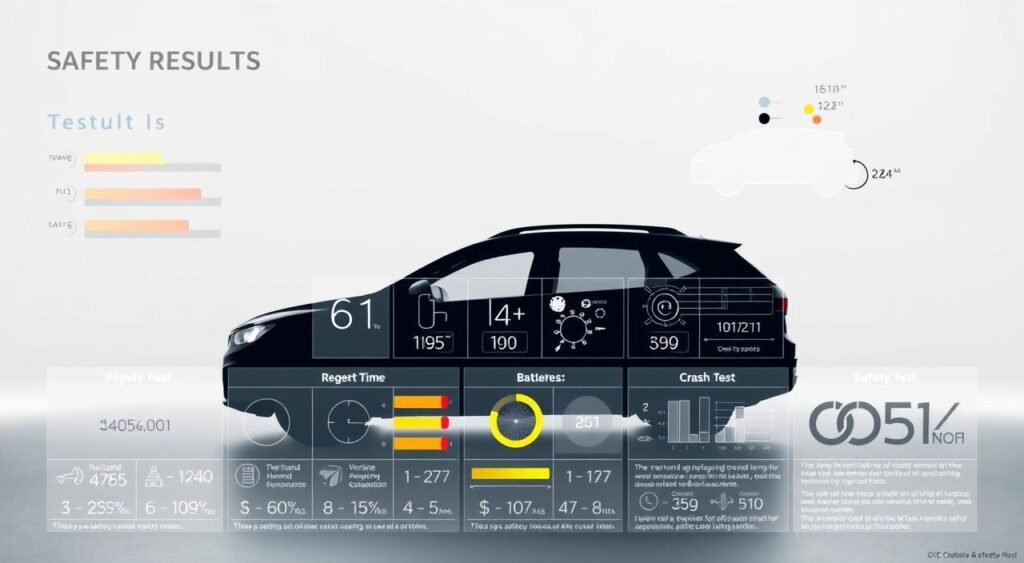
Each area gets a score, and these scores add up to the final rating. Cars with 5 Stars do great in all tests. They show top-notch engineering and safety design.
How Ratings Affect Consumer Choices
In India, car buyers focus more on safety. A car with a 5 Stars Safety Rating is more trusted. It might also cost more, but buyers are willing to pay for safety.
This trend affects more than just personal buyers. Companies that buy cars also look for high safety ratings. This pushes car makers to focus more on safety. It’s a win for everyone on the road.
Details of the BNCAP Crash Test
The Maruti Suzuki Victoris was tested by Global NCAP to get a 5-star safety rating. It went through many crash tests to check how safe it is for adults and kids. These tests help us know how safe a car is in real accidents.
Testing Methodology
The BNCAP crash test uses strict rules to get accurate results. It tests how a car does in a head-on crash and when hit from the side. It also checks how a car does when it slides into a pole.
Results Breakdown
The Victoris did very well in all crash tests. It got perfect scores for keeping kids safe. It did great in side impact tests, showing it’s safe all over.
| Test Category | Score Achieved | Maximum Score |
|---|---|---|
| Child Frontal Protection | 8 | 8 |
| Child Side Protection | 4 | 4 |
| CRS Installation | 12 | 12 |
| Vehicle Assessment | 5 | 13 |
Comparison with Other Vehicles
Compared to other cars in its class, the Victoris is a clear winner. Many cars in this price range don’t do as well in safety tests. But the Victoris got perfect scores, making it one of the safest cars in India.
Impact of 5-Star Rating on Sales
The link between crash test ratings and car sales is growing in India. A car’s top safety scores can sway buyer choices and its market standing. The Maruti Suzuki Victoris Safety getting 5 Stars in crash tests is a big deal for its sales.
Anticipated Market Response
Experts think the Victoris’s safety win will draw a lot of interest. It got 5 Stars in BNCAP and is likely to do well in Global NCAP too. Dealers say they’re getting more calls after the safety news.
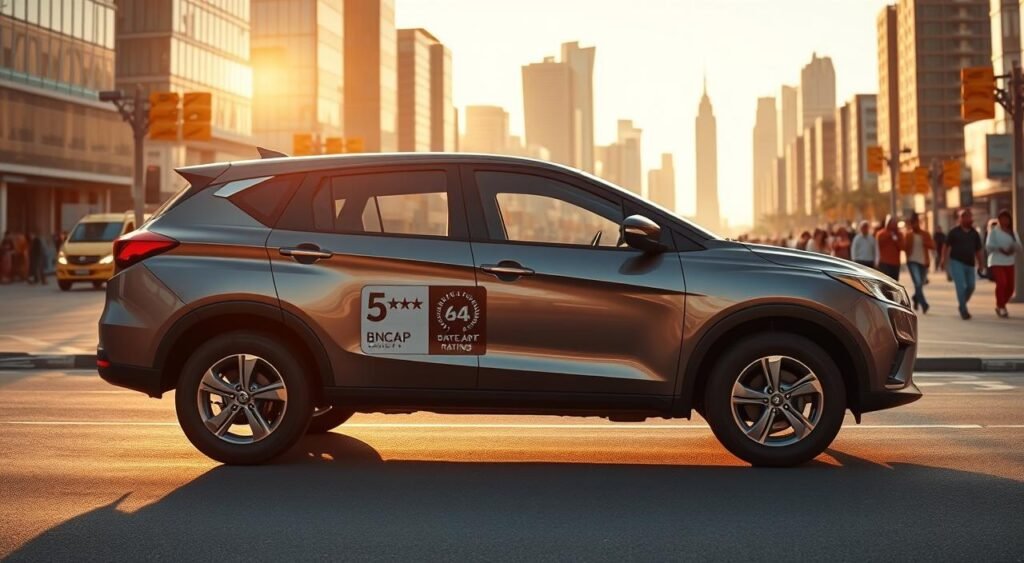
The Maruti Suzuki Victoris Safety win will likely pull in buyers who care about safety. In India, people now value safety as much as fuel efficiency and price.
Historical Context of Ratings and Sales
Looking back, safety ratings and sales in India show a clear link:
| Vehicle Model | Safety Rating | Sales Impact (First 6 Months) | Market Share Change |
|---|---|---|---|
| Tata Nexon | 5 Stars (2018) | +47% | +2.3% |
| Mahindra XUV300 | 5 Stars (2020) | +38% | +1.8% |
| Tata Altroz | 5 Stars (2020) | +42% | +1.5% |
| Maruti Suzuki Dzire | 5 Stars (2024) | +35% | +2.1% |
The Dzire’s success after getting 5 Stars shows Maruti’s focus on safety. This suggests the Victoris will see a boost in sales when it hits the market this month.
Consumer Reactions to the Rating
The Maruti Suzuki Victoris has excited many in India. Its 5-star rating in safety has raised the bar for cars in the country. This makes it a top choice for those looking for safety.
Feedback from Owners
Victoris owners are very happy with their choice. They love the car’s safety features. The six airbags in every model are a big hit with families.
People also talk about the car’s strong body in crash tests. Parents like the extra safety features in the higher models. These make them feel safer on the road.
Online Reviews and Discussions
Online, people are talking a lot about the Victoris’s safety. Social media is full of stories where the car’s safety helped avoid accidents. Or made injuries less severe.
| Review Platform | Average Rating | Key Praise Points |
|---|---|---|
| CarDekho | 4.6/5 | Build quality, safety features |
| CarWale | 4.5/5 | Crash test performance, airbag system |
| Team-BHP Forums | 4.7/5 | Structural integrity, safety technology |
Online, car lovers say safety is key for them. The Victoris shows Maruti Suzuki is listening to what people want. It’s a big step forward for the brand.
Maruti Suzuki’s Commitment to Safety
Maruti Suzuki is making a big push for safer cars. They use the latest tech and add lots of safety features. Their recent success in crash tests shows they’ve been working hard to make cars safer for everyone.
Innovations in Safety Technology
The Maruti Suzuki Victoris Safety package has some cool features. It has Electronic Stability Control (ESC) and traction control to stop skidding. It also has hill hold assist and ISOFIX child seat mounts on all models.
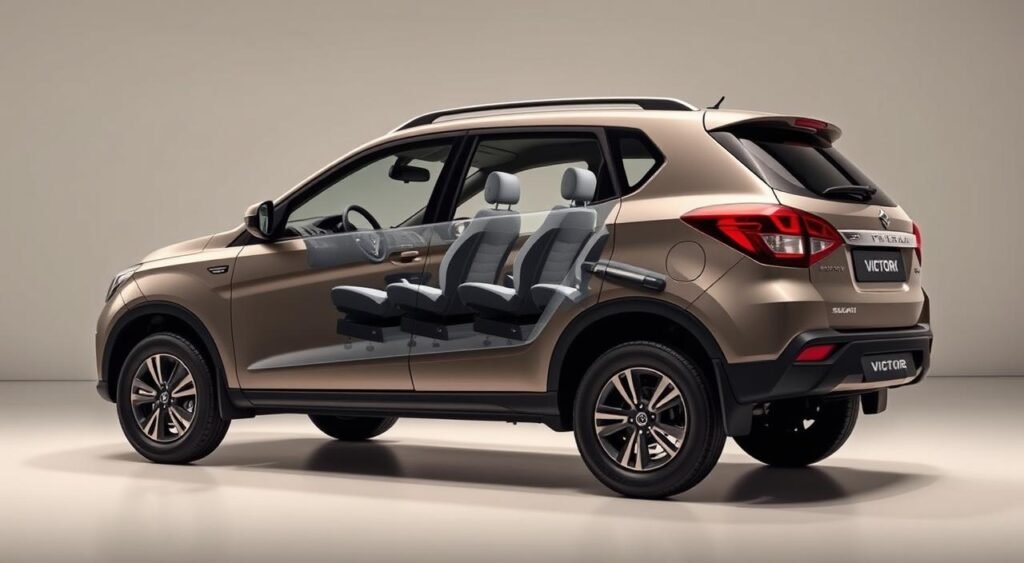
The top versions of the Victoris have advanced safety tech. This includes adaptive cruise control and lane keeping assist. It also has an electronic parking brake and a 360-degree camera for better visibility.
Previous Vehicles with High Safety Ratings
Maruti Suzuki has been getting better at making safe cars. The Dzire got a 5-star Global NCAP Safety Rating in November 2024. This was a big win for the brand.
| Model | Safety Rating | Year Tested | Key Safety Features |
|---|---|---|---|
| Dzire | 5 Stars | 2024 | 6 airbags, ESC, ABS |
| Brezza | 4 Stars | 2023 | Dual airbags, ABS, EBD |
| Baleno | 3 Stars | 2022 | Dual airbags, ABS |
This shows how Maruti Suzuki has grown in making cars safer. They’ve improved the car’s structure and added more safety features.
The Role of Crash Tests in Vehicle Development
Crash tests are key in making cars safer. They help car makers improve their designs. By testing cars, engineers find ways to make them safer for everyone.
Safety Features Being Developed
The Victoris is a top example of safe car design. Its bodyshell is very stable, getting high scores in tests. It did well in tests for adult safety, getting 15.807 out of 16 points.
Keeping kids safe is also a big focus. The Victoris got perfect scores in tests for child safety. It passed tests with 18-month and 3-year-old dummies in front and side crashes.
Continuous Improvement in Design
Crash tests help engineers make cars better. They look at how to improve things like crumple zones and airbags. The Victoris shows how years of testing can lead to a safer car.
| Test Type | Score Achieved | Maximum Points |
|---|---|---|
| Frontal Offset Deformable Barrier | 15.807 | 16.000 |
| Side Movable Deformable Barrier | 15.913 | 16.000 |
| Child Restraint Dynamic Score | 24.000 | 24.000 |
This careful testing makes cars safer over time. It helps make sure every new car is better than the last.
Regulatory Impact on Vehicle Design
Vehicle safety standards in India have changed a lot in recent years. The Maruti Suzuki Victoris shows how makers adjust their designs to meet new rules. These rules make cars safer while keeping prices and performance good.
Changes in Safety Regulations
India’s car safety rules changed a lot in 2019. Now, every new car must have:
- Dual front airbags
- ABS (Anti-lock Braking System)
- Rear parking sensors
- Speed alert system
- Seatbelt reminder
The Victoris goes beyond these rules by having six airbags in all models. This focus on safety helped it get a high Safety Rating in India and worldwide.
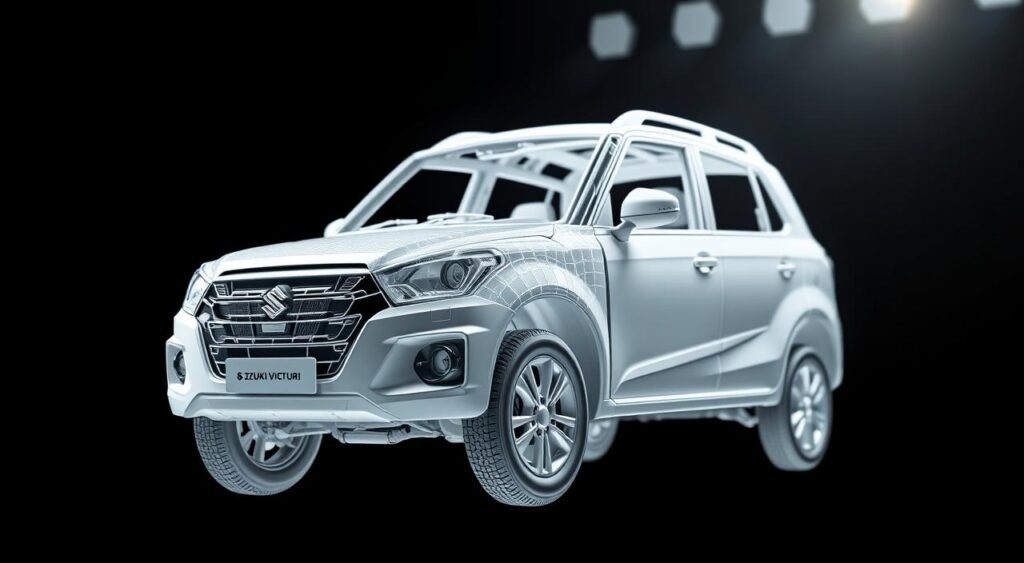
Future Implications for Manufacturers
The Victoris’s success in the BNCAP Crash Test raises the bar for the industry. Car makers are under pressure to meet or beat these standards. Companies that invest in safety tech get ahead in the Indian market.
Future rules will likely ask for better protection for pedestrians and more advanced driver aids. Makers need to add these features early on, not just later. The Victoris shows it’s possible to be safe without making cars too expensive.
Future Outlook for Maruti Suzuki
The Maruti Suzuki Victoris getting 5 stars in BNCAP crash tests marks a big change for India’s top car maker. This achievement sets the stage for the company to change its market plans at home and abroad. The Victoris will be key to their big growth plans.
Upcoming Models and Innovations
Maruti Suzuki aims to add more safety features to all its cars after the Victoris’s success. They are working on new models with:
- Stronger bodies made with high-tensile steel
- Standard driver assistance systems (ADAS)
- Better airbags for more safety
- Smart tech for quick emergency help
The Victoris will help shape future cars from Maruti Suzuki, keeping safety high across all prices. Engineers are making these cars safer without making them too expensive, which is important for Indian buyers.
Expansion Plans in Global Markets
The Victoris’s 5 stars rating opens up new chances for Maruti Suzuki in global markets. They aim to grow in:
- Southeast Asia, where safety is key
- Africa, where people want reliable, safe cars
- Latin America, where safety is becoming more important
Maruti Suzuki will offer different engine options like petrol, hybrid, and CNG. This lets them tailor the Victoris to fit different markets while keeping safety at the top.
The Victoris’s Design and Engineering
The Maruti Suzuki Victoris is a big step forward in car design. It combines looks with top-notch engineering. Its strong structure is key to its great crash test results. This shows how good design helps keep passengers safe.
Aesthetic Aspects and User Experience
The Victoris has a bold front grille and sleek LED headlamps. These improve visibility and safety. Its body shape cuts down wind resistance while staying strong.
The inside of the car focuses on clear views for the driver. It has controls that are easy to reach. This makes driving safer and more comfortable.
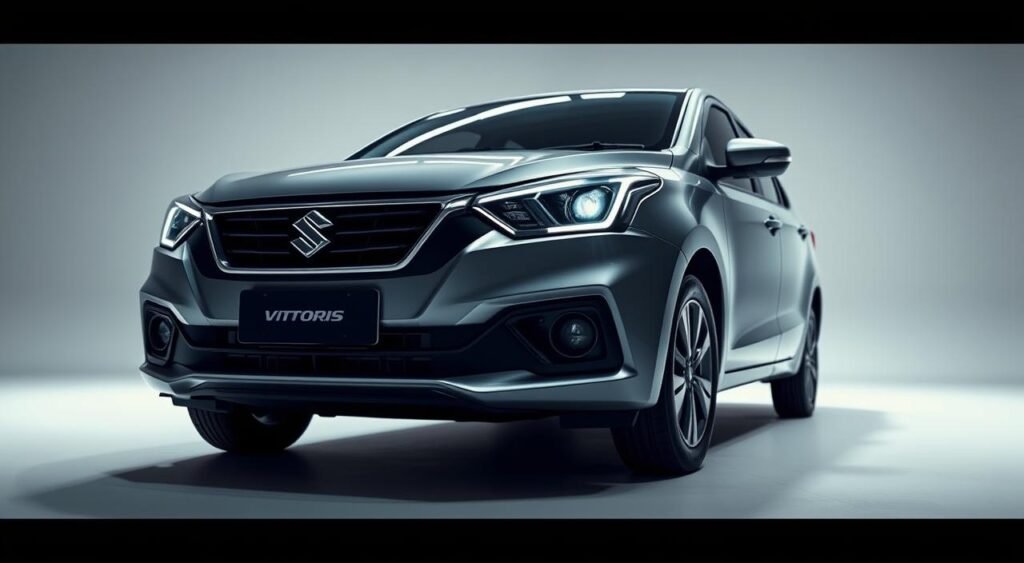
The cabin is made with premium materials to soak up shock in crashes. The dashboard is soft to the touch and helps protect against extra impacts.
Engineering Innovations Contributing to Safety
The Victoris’s safety is built into its design. It uses high-tensile steel in key spots. This creates zones that absorb shock before it reaches the people inside.
- Level 2 ADAS technology in higher variants
- 360-degree camera system for enhanced visibility
- Electronic parking brake with auto-hold function
- Reinforced door beams and side-impact protection
These features work together to protect important body areas in crashes. The Victoris shows Maruti Suzuki’s dedication to safety. It goes beyond what’s expected in the industry.
Community and Environmental Considerations
The car industry has a big challenge. It must balance being green with keeping drivers safe. The Maruti Suzuki Victoris shows it’s possible to do both well.
This car proves you can choose an eco-friendly vehicle. And you don’t have to give up safety for your family.
How Safety Ratings Influence Eco-Friendly Practices
When cars get high safety ratings, like the Victoris, it pushes makers to go green. The 5-star BNCAP rating shows that safe cars can also be eco-friendly.
This change affects the industry in many ways:
- Engineers use lighter materials that are strong
- Batteries in hybrids are placed to protect in crashes
- CNG tanks are installed safely
- Technologies that cut emissions work with safety features
Maruti Suzuki’s Sustainable Initiatives
The Victoris shows Maruti Suzuki’s dedication to green cars. It offers hybrid, CNG, and efficient petrol engines. Each one has the same safety features, so you’re always protected.
Some key green features are:
- Hybrid tech cuts fuel use by up to 40%
- CNG models reduce emissions but keep performance high
- Light materials make the car more efficient without losing safety
- Recyclable materials are used in the car’s interior and body
The Maruti Suzuki Victoris is a leader in safe, green cars. It helps communities breathe cleaner air and keeps families safe on the road.
Conclusion: The Significance of the 5-Star Rating
The Maruti Suzuki Victoris has earned a 5-star rating in the BNCAP crash test. This is a big win for the company. It shows the Victoris is one of the safest cars in its class.
The car’s Adult Occupant Protection score is 33.72 out of 34. Its Child Occupant Protection score is 41 out of 49. These scores are very high and meet global safety standards.
Summary of Key Points
The Victoris has six airbags, Electronic Stability Control, and advanced driver assistance systems. These features helped it get a 5-star rating in both BNCAP and Global NCAP tests. Now, it can compete with cars like the Hyundai Creta and Kia Seltos in safety.
This safety package shows Maruti Suzuki’s dedication to keeping drivers and passengers safe. It also meets the latest safety rules.
The Future of Maruti Suzuki Victoris in the Market
The 5-star rating will help the Victoris do well in both India and other countries. In India, people who care about safety look at crash test ratings when buying a car. The Victoris’s 5-star rating will make more people trust the car and want to buy it.
This success helps Maruti Suzuki grow in the competitive SUV market. It also sets new safety standards for cars.
FAQ
What safety ratings did the Maruti Suzuki Victoris achieve in crash tests?
The Maruti Suzuki Victoris got 5-star ratings in BNCAP and Global NCAP crash tests. It scored 33.72 out of 34 points for Adult Occupant Protection (AOP) and 41 out of 49 points for Child Occupant Protection (COP). This makes it Maruti Suzuki’s first car to score 5 stars in Global NCAP.
What safety features come standard in the Maruti Suzuki Victoris?
All Victoris variants have six airbags, electronic stability control (ESC), traction control, ABS with EBD, hill hold assist, and ISOFIX child seat anchor points. They also have 3-point seatbelts with reminders, rear parking sensors, and overspeed alerts. Higher variants add a 360-degree camera, electronic parking brake with auto hold, and Level 2 ADAS.
How did the Victoris perform in specific crash test scenarios?
In frontal offset deformable barrier tests, the Victoris scored 15.807/16 points. This shows good protection for the driver’s head, neck, pelvis, thighs, left tibia, and feet. The side movable deformable barrier test yielded 15.913/16 points. Child restraint system testing achieved perfect dynamic scores of 24/24 points.
What powertrains are available for the Maruti Suzuki Victoris?
The Victoris comes with petrol, hybrid, and CNG powertrains. All powertrains have the same high safety standards and features. This shows that environmental considerations don’t compromise occupant protection.
Which vehicles does the Maruti Suzuki Victoris compete against?
The Victoris competes in the midsize SUV segment. It faces off against the Maruti Grand Vitara, Toyota Hyryder, Kia Seltos, Hyundai Creta, Tata Curvv, Skoda Kushaq, and Volkswagen Taigun. Its dual 5-star safety ratings make it one of the safest options in this competitive segment.
How does the Victoris compare to other Maruti Suzuki models in terms of safety?
The Victoris is Maruti Suzuki’s first car to achieve 5 stars in both AOP and COP categories in Global NCAP. It follows the Dzire, which achieved a 5-star Global NCAP rating in November 2024. This shows Maruti’s enhanced commitment to safety standards.
What is the significance of the bodyshell integrity rating?
The Victoris’s bodyshell integrity was marked as stable during crash tests. This indicates the vehicle’s structure can withstand impacts effectively. This rating reflects advanced structural design and engineering excellence in the SUV’s safety architecture.
When will the Maruti Suzuki Victoris launch in India?
The Victoris is set to launch in India this month. The dual 5-star ratings are expected to boost both domestic sales and support Suzuki’s export plans for international markets.
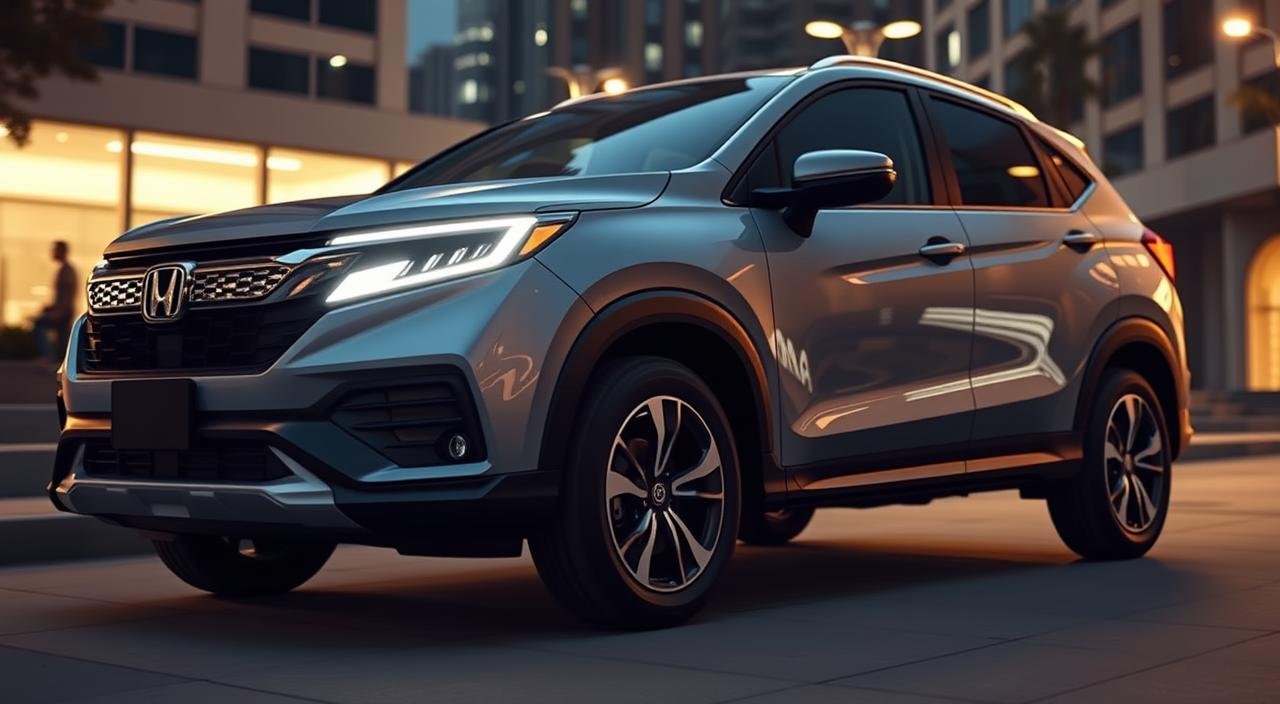
Oct
Can a few strategic updates turn an SUV into a top contender? Honda thinks yes with its updated Elevate, perfect for India’s festival season. The compact SUV market is tough, and Honda wants to boost the Elevate’s standing.
The updated Honda Elevate comes with new looks and better inside features. It keeps its strong 1.5-liter i-VTEC petrol engine. Prices start at Rs 11.91 lakh and go up to Rs 16.81 lakh (ex-showroom).
It has 458 liters of boot space and seats that fold 60:40. The 2650mm wheelbase makes the inside roomy. Plus, GST changes mean prices could drop by up to Rs 58,400 from September 22.
This review looks at if the Elevate’s updates make it worth considering. With new looks, useful features, and good prices, it’s a solid choice for city driving.
Key Takeaways
- Honda Elevate receives design and interior updates for the festival season
- Prices range from Rs 11.91 lakh to Rs 16.81 lakh with GST benefits up to Rs 58,400
- Retains the reliable 1.5-liter i-VTEC petrol engine
- Offers 458 liters of boot space with expandable 60:40 folding seats
- Measures 4312mm in length with a 2650mm wheelbase for spacious interiors
- Cosmetic updates aim to keep the compact SUV competitive in its segment
Overview of the Honda Elevate’s Latest Updates
The updated Honda Elevate comes with new design elements and modern features. These changes make driving more enjoyable. The SUV now has more customization options and premium touches across different variants.
The refreshed model tackles previous issues while keeping its competitive edge. It stands out in the mid-size SUV segment.
Key Changes in Design and Style
The Honda Elevate Bold Looks package introduces the striking Alpha-Bold Plus Grille option. This design makes the SUV’s front look more aggressive and bold. Crystal Black Pearl paint is now available across V, VX, and ZX variants, adding a sophisticated look.
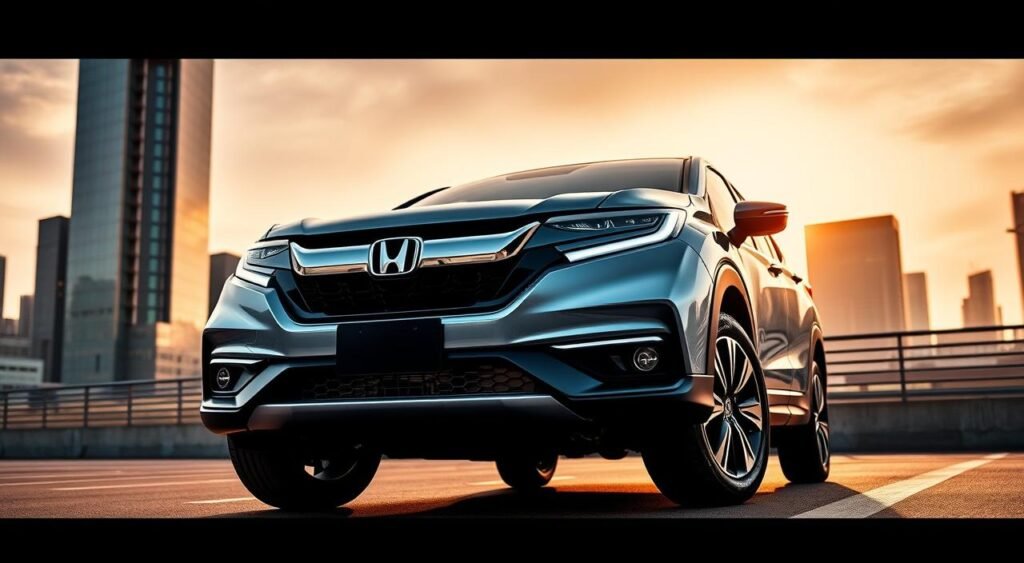
Enhanced Interior Features
The interior of the Honda Elevate has been improved for more comfort. The ZX grade has an elegant Ivory and Black two-tone cabin. It comes with leatherette seats and soft-touch inserts.
Lower V and VX grades have new all-black fabric seats with ivory accents. These replace the previous Shadow Beige upholstery for a sportier look.
New Technology Integrations
Technology upgrades have made the Elevate more convenient and comfortable. The ZX variant offers an optional 360-degree camera system for better visibility during parking. Seven-color ambient lighting lets drivers customize the cabin atmosphere.
These tech additions make the updated Elevate a modern, connected vehicle. It meets today’s expectations.
Bold Exterior Enhancements
The updated Honda Elevate stands out with its strong look and sleek design. It has a commanding presence on the road, making it stand out in the compact SUV market. The design changes highlight the SUV’s better performance while keeping it practical for Indian roads.
Revised Grille and Headlights
The front of the Honda Elevate has been completely revamped. It now has a large, upright grille with thick chrome accents. This bold grille, along with a flat bonnet, gives the SUV a powerful look. The angular headlights blend well with the grille, making the Elevate look modern.
Diamond-cut 17-inch alloy wheels add to the strong front design. Protective cladding also highlights the SUV’s rugged side.
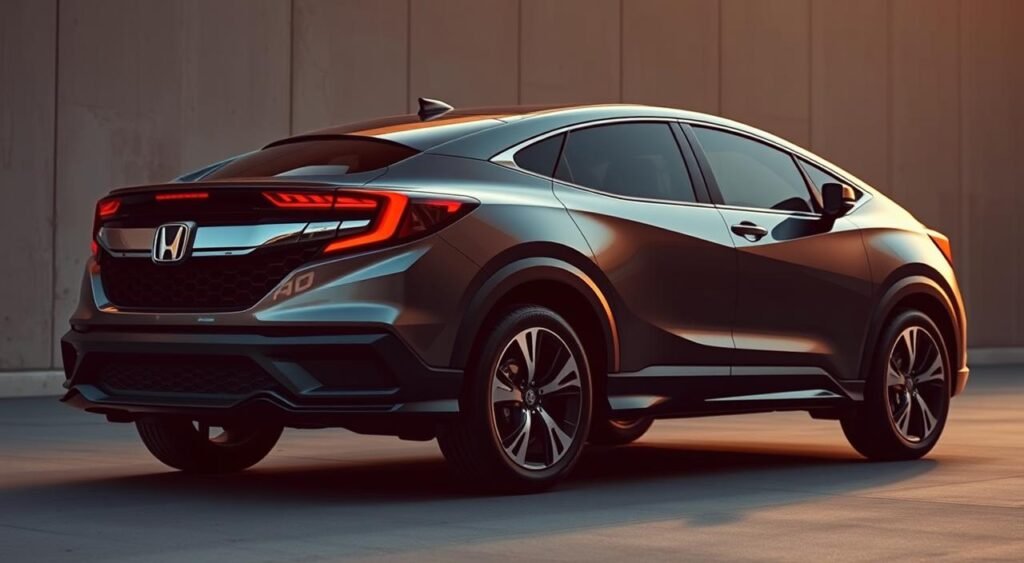
Sporty Body Lines and Colors
Sharp lines run along the side, creating a dynamic look from front to back. The thick C-pillar adds strength to the design. At the back, connected tail lamps with crisp edges make the SUV look wider and more stable.
Color options include:
- Single-tone finishes: Phoenix Orange Pearl, Obsidian Blue Pearl, Radiant Red Metallic, Platinum White Pearl, Golden Brown Metallic, Lunar Silver Metallic, and Meteoroid Gray Metallic
- Dual-tone options: Three combinations with Crystal Black Pearl roofs
- Black Editions: Base Black Edition with dark paint and silver accents, plus Signature Black Edition featuring complete black-out treatment including interior and Alpha-Bold Plus grille
Interior Comfort and Upgrades
The Honda Elevate Updated cabin offers a premium feel with top-notch materials and design. Soft-touch surfaces cover the dashboard, paired with wooden inserts and fine accents. These touches make every drive feel luxurious, whether in the city or on the highway.
Seating and Space Improvements
The seating in the Honda Elevate Features lineup has seen big upgrades. The seats are covered in plush fabric and are very supportive. The front seats, inspired by the Honda City, offer great cushioning and design.
Rear passengers get lots of legroom and headroom from the smart roof design. Big windows let in plenty of natural light. The seats recline for comfort on long trips. This design fits five adults comfortably.
Infotainment System Innovations
The 10.25-inch touchscreen infotainment system is the star of the show. It supports wireless Apple CarPlay and Android Auto, making it cable-free. The 7-inch semi-digital instrument cluster combines analog and digital smoothly.
- Electric sunroof with tilt and slide functions
- Pinch guard safety feature for sunroof operation
- Single-zone automatic climate control with intuitive controls
- 8-speaker sound system for immersive audio
The climate control system has a slim display with easy-to-use toggles and buttons. This design lets drivers adjust settings without taking their eyes off the road.
Performance and Efficiency
The Honda Elevate Performance shines with its well-tuned engine. It’s perfect for daily use and long trips. It’s built for Indian roads, giving you reliable power and great fuel economy.
Engine Options and Power Output
The Honda Elevate Review shows it has one engine for all models. A 1.5-liter four-cylinder engine makes 121 PS (119 bhp) at 6,600 rpm. It also has 145 Nm of torque at 4,300 rpm.

There are two transmission choices: a 6-speed manual or a CVT automatic. The engine provides steady power, making city driving easy. It also performs well when you need to speed up.
Fuel Economy Ratings
Fuel efficiency is a key feature of the Honda Elevate Performance. The ARAI-certified figures are impressive:
| Transmission Type | ARAI Mileage | Real-World Average |
|---|---|---|
| 6-Speed Manual | 15.31 kmpl | 14.0 kmpl |
| CVT Automatic | 16.92 kmpl | 14.94 kmpl |
In the city, you get about 10 kmpl with AC and 12 kmpl without. On highways, it’s 16 kmpl with AC on. The 220mm ground clearance helps it handle rough roads well, without losing fuel efficiency.
Safety Features Introduced
The updated Honda Elevate focuses on keeping passengers safe with top-notch safety tech. It has both active and passive safety systems for a secure ride. The Elevate’s specs include many airbags, advanced driver aids, and a strong build that scored well in crash tests.
Advanced Driver Assistance Systems
The Honda Sensing suite adds the latest in safety tech to the Elevate. It has a Collision Mitigation Braking System (CMBS) that stops the car if it’s about to crash. Adaptive cruise control keeps a safe distance from cars in front on highways.
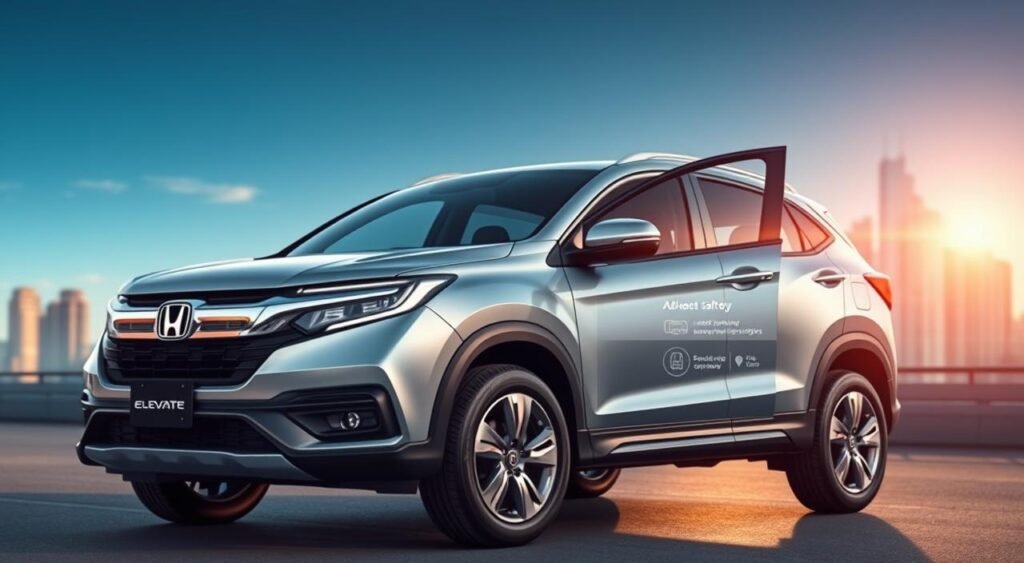
The Lane Keeping Assist System (LKAS) stops you from drifting out of your lane by helping steer. A multi-angle rearview camera gives a 180-degree view with lines for safer backing up. The LaneWatch camera shows blind spots on the screen when you turn right.
Crash Test Ratings and Confidence
JNCAP gave the Honda Elevate a five-star crash test safety rating. This high score means it does well in frontal and side impact tests. It also has six airbags for extra protection in crashes.
| Safety Feature | Function |
|---|---|
| Electronic Stability Control | Prevents skidding and loss of control |
| Hill Start Assist | Prevents rollback on inclines |
| Brake Assist | Maximizes braking force in emergencies |
| Auto-dimming IRVM | Reduces glare from following vehicles |
The Honda Elevate has ABS with EBD for better braking. Parking sensors make it easier to park in small spaces. Even though the safety features are impressive, some, like rear cross-traffic alert, are missing from this model.
Pricing and Value Analysis
The Honda Elevate starts at Rs 11.95 lakh for the base SV MT model. It goes up to Rs 17.07 lakh for the top ZX CVT Dual Tone. Buyers should think if the Elevate fits their budget and needs.
Comparison with Competitors
The Elevate competes in a tough market. Here’s how it compares to main rivals:
| Model | Starting Price | Top Variant Price | Engine Options |
|---|---|---|---|
| Honda Elevate | Rs 11.95 lakh | Rs 17.07 lakh | Petrol only |
| Hyundai Creta | Rs 11.00 lakh | Rs 20.15 lakh | Petrol, Diesel |
| Kia Seltos | Rs 10.90 lakh | Rs 20.35 lakh | Petrol, Diesel |
| Maruti Grand Vitara | Rs 10.99 lakh | Rs 19.93 lakh | Petrol, Hybrid |
The Elevate’s price is in the middle of the pack. It doesn’t offer diesel or hybrid options, which might not appeal to all. But it has good safety and tech features across all models.
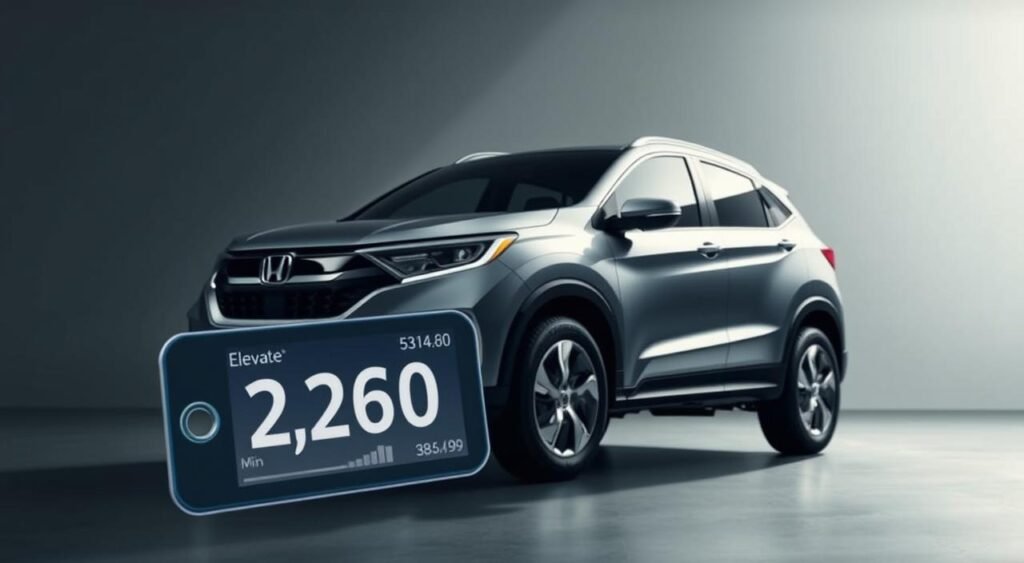
Overall Cost of Ownership
Ownership costs include registration, insurance, and maintenance. The base model costs around Rs 151,806 for registration and Rs 47,648 for insurance. The top model costs Rs 220,687 for registration and Rs 76,698 for insurance.
The Elevate runs on petrol, which is simpler but might cost more to fuel. Honda’s reliability and strong resale value make it a good long-term choice.
Customer Reviews and Market Reception
The updated Honda Elevate has caught the attention of many in India. It has an average rating of 4.6 out of 5 stars from 306 reviews. People love its engine and interior design, making it stand out.
User Experiences and Feedback
Reviews highlight several favorite features. The seats are comfy, and the exterior design handles Indian roads well. Drivers enjoy smooth handling and quick acceleration.
But, there are areas for improvement. Some find the cabin too noisy, and the rear mirrors lack proximity sensors. There are also issues with the ADAS front camera causing sudden braking. Missing features like ventilated seats and a panoramic sunroof are also noted.
Sales Performance
Despite festive offers, the market reception is mixed. Honda’s Great Honda Fest campaign offers big discounts. But, the lack of a diesel engine and competition from Hyundai and Kia are challenges.
Dealers see more traffic during festivals. Yet, Honda needs more engine options to win more customers.
FAQ
What are the key updates in the Honda Elevate?
The Honda Elevate has some big updates. It now has a new Alpha-Bold Plus Grille option. The ZX grade gets a premium Ivory and Black two-tone interior with leatherette seats.
FAQ
What are the key updates in the Honda Elevate?
The Honda Elevate has some big updates. It now has a new Alpha-Bold Plus Grille option. The ZX grade gets a premium Ivory and Black two-tone interior with leatherette seats.
FAQ
What are the key updates in the Honda Elevate?
The Honda Elevate has some big updates. It now has a new Alpha-Bold Plus Grille option. The ZX grade gets a premium Ivory and Black two-tone interior with leatherette seats.
What is the price range for the updated Honda Elevate?
FAQ
What are the key updates in the Honda Elevate?
The Honda Elevate has some big updates. It now has a new Alpha-Bold Plus Grille option. The ZX grade gets a premium Ivory and Black two-tone interior with leatherette seats.
FAQ
What are the key updates in the Honda Elevate?
The Honda Elevate has some big updates. It now has a new Alpha-Bold Plus Grille option. The ZX grade gets a premium Ivory and Black two-tone interior with leatherette seats.
What are the Honda Elevate specs and dimensions?
FAQ
What are the key updates in the Honda Elevate?
The Honda Elevate has some big updates. It now has a new Alpha-Bold Plus Grille option. The ZX grade gets a premium Ivory and Black two-tone interior with leatherette seats.
FAQ
What are the key updates in the Honda Elevate?
The Honda Elevate has some big updates. It now has a new Alpha-Bold Plus Grille option. The ZX grade gets a premium Ivory and Black two-tone interior with leatherette seats.
What engine powers the Honda Elevate and what’s its performance?
FAQ
What are the key updates in the Honda Elevate?
The Honda Elevate has some big updates. It now has a new Alpha-Bold Plus Grille option. The ZX grade gets a premium Ivory and Black two-tone interior with leatherette seats.
FAQ
What are the key updates in the Honda Elevate?
The Honda Elevate has some big updates. It now has a new Alpha-Bold Plus Grille option. The ZX grade gets a premium Ivory and Black two-tone interior with leatherette seats.
What safety features does the Honda Elevate offer?
FAQ
What are the key updates in the Honda Elevate?
The Honda Elevate has some big updates. It now has a new Alpha-Bold Plus Grille option. The ZX grade gets a premium Ivory and Black two-tone interior with leatherette seats.
FAQ
What are the key updates in the Honda Elevate?
The Honda Elevate has some big updates. It now has a new Alpha-Bold Plus Grille option. The ZX grade gets a premium Ivory and Black two-tone interior with leatherette seats.
How does the Honda Elevate compare with competitors?
FAQ
What are the key updates in the Honda Elevate?
The Honda Elevate has some big updates. It now has a new Alpha-Bold Plus Grille option. The ZX grade gets a premium Ivory and Black two-tone interior with leatherette seats.
FAQ
What are the key updates in the Honda Elevate?
The Honda Elevate has some big updates. It now has a new Alpha-Bold Plus Grille option. The ZX grade gets a premium Ivory and Black two-tone interior with leatherette seats.
Is the Honda Elevate worth it based on customer reviews?
FAQ
What are the key updates in the Honda Elevate?
The Honda Elevate has some big updates. It now has a new Alpha-Bold Plus Grille option. The ZX grade gets a premium Ivory and Black two-tone interior with leatherette seats.
FAQ
What are the key updates in the Honda Elevate?
The Honda Elevate has some big updates. It now has a new Alpha-Bold Plus Grille option. The ZX grade gets a premium Ivory and Black two-tone interior with leatherette seats.
What special editions are available for the Honda Elevate?
FAQ
What are the key updates in the Honda Elevate?
The Honda Elevate has some big updates. It now has a new Alpha-Bold Plus Grille option. The ZX grade gets a premium Ivory and Black two-tone interior with leatherette seats.
FAQ
What are the key updates in the Honda Elevate?
The Honda Elevate has some big updates. It now has a new Alpha-Bold Plus Grille option. The ZX grade gets a premium Ivory and Black two-tone interior with leatherette seats.

Oct
Could September 2025 be a game-changer for India’s car market? It’s set to see a flood of new car releases. These changes could alter how people choose their next vehicle.
Six big names are ready to show off their latest models in September 2025. Maruti Suzuki will kick things off with a new SUV on September 3rd. VinFast will introduce two electric cars in India on September 6th. Citroen will unveil the Basalt X on September 5th. Mahindra will update the Thar, and Volvo will launch the EX30 by the end of the month.
These new cars will cost between Rs 9.7 lakh and Rs 50 lakh. This range offers something for everyone, from budget-friendly SUVs to high-end electric vehicles. It shows how India’s car market is growing, with both traditional and electric options available.
Key Takeaways
- Six major car brands schedule launches throughout September 2025
- Price points range from Rs 9.7 lakh to Rs 50 lakh across different segments
- VinFast enters India with two electric models on September 6th
- Maruti Suzuki kicks off the month with a new SUV on September 3rd
- Electric and traditional fuel options provide diverse choices for buyers
- Mahindra Thar receives updates while maintaining its rugged appeal
- Volvo EX30 brings Swedish safety innovation to the electric segment
Overview of September 2025 Car Launches
September 2025 is a big month for the car world. Many new vehicles will be shown off, combining the latest tech with designs that people love. This month, we’ll see more electric cars, affordable luxury, and better safety features.

What to Expect from the Latest Models
This month, there’s something for everyone. Maruti’s new SUV is perfect for those who want something in between the Brezza and Grand Vitara. VinFast is launching two electric SUVs in Tamil Nadu. Citroen is adding a premium touch to the Basalt X with black finishes and ambient lights.
Mahindra is updating the Thar with a modern twist, keeping its rugged charm. Volvo is joining the electric compact car market with the EX30, showing their dedication to green cars.
Exciting Innovations in Design and Technology
September will bring big tech leaps in cars. Some highlights include:
- Panoramic sunroofs becoming standard in mid-segment vehicles
- Level-2 ADAS (Advanced Driver Assistance Systems) for enhanced safety
- 360-degree camera systems for improved visibility
- Larger touchscreen displays reaching up to 12.9 inches
- Wireless charging capabilities and ventilated seats
- Advanced battery technologies for up to 496 kilometers range
These new cars show how manufacturers are listening to what people want. They’re making tech-rich, eco-friendly cars that are also affordable.
Spotlight on Maruti Escudo
The Maruti Escudo is one of the most awaited cars in September 2025. It’s a big step for Maruti to enter the mid-size SUV market. Built on Suzuki’s Global C platform, it offers great value and reliability.
Key Features of the Maruti Escudo
The Maruti Escudo has features that match high-end cars. It has a long wheelbase for more space, perfect for Indian families. All models come with:
- Panoramic sunroof for an airy feel
- Ventilated front seats for comfort in hot weather
- Six airbags for safety
- 360-degree camera system for easy parking
- Advanced Driver Assistance Systems (ADAS) in higher variants
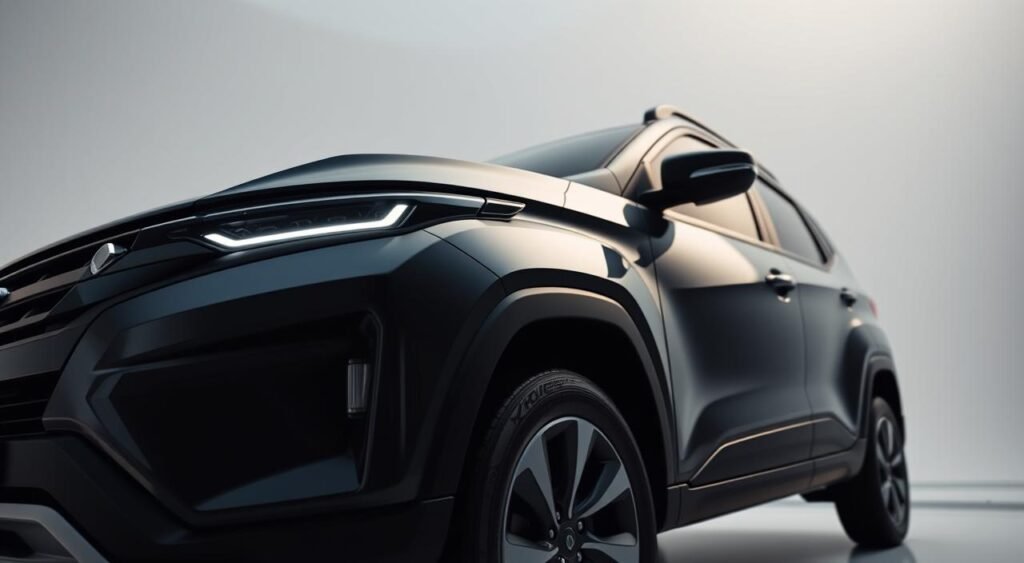
It has three engine options. The 1.5-liter petrol engine has mild-hybrid tech for better fuel use. There’s also a strong hybrid and a CNG option for those who want to save money.
Pricing and Availability Timelines
The Maruti Escudo launches on September 3, 2025, starting at Rs 9.7 lakh (ex-showroom). It’s priced well between the Brezza and Grand Vitara. It will be sold through Arena dealerships across India.
Bookings start in late August 2025. Deliveries will begin right after the launch. Thanks to Maruti’s production and dealer network, there won’t be long waits.
Spotlight on Volvo EX30
The Volvo EX30 is a standout in September 2025 car launches. It’s Volvo’s most compact electric vehicle. This car brings premium electric mobility to a new market.
It’s expected to hit dealerships by late September. The price is around Rs 50 lakh. The EX30 is a gateway to Volvo’s electric future.
Unique Selling Propositions of the EX30
The Volvo EX30 showcases Scandinavian design in the compact electric segment. Its exterior features Thor hammer-shaped LED daytime running lights. This makes it instantly recognizable.
The car has 19-inch aerodynamic alloy wheels. These wheels boost efficiency and look great. L-shaped LED tail lights add to its modern look.
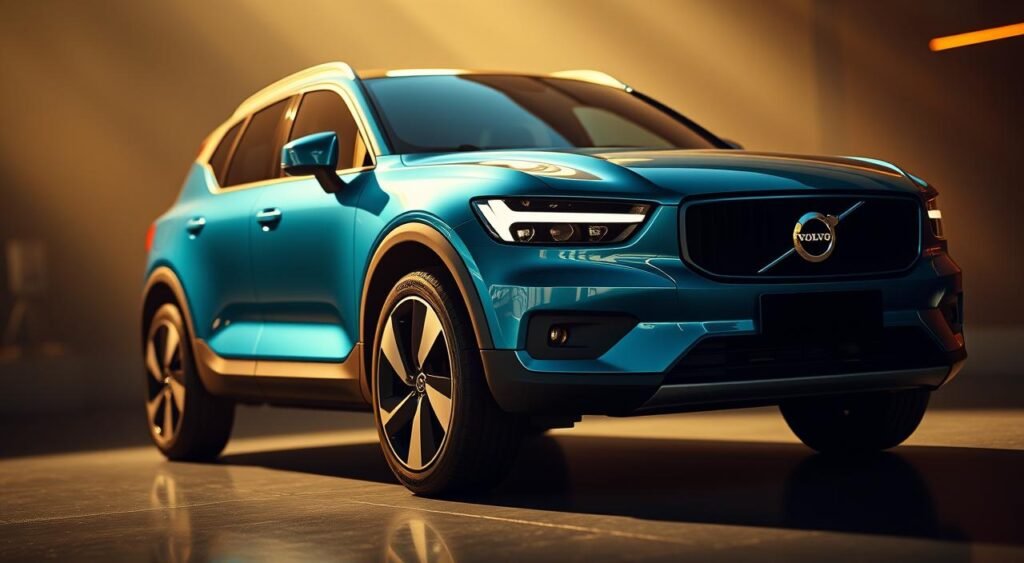
Inside, the EX30 is all about minimalism. It has a 12.3-inch central touchscreen for controlling most functions. It also has:
- Fixed panoramic glass roof for an airy feel
- Dual-zone climate control for comfort
- Wireless charging for devices
- Single 69 kWh battery pack
- Rear-wheel drive system with 272 PS motor
- WLTP-certified range of 480 kilometers
Safety Innovations in Volvo Vehicles
Volvo is known for its safety, and the EX30 is no exception. It comes with seven airbags for protection. A 360-degree camera system offers full visibility.
Advanced Driver Assistance Systems (ADAS) help prevent collisions. These features show Volvo’s dedication to safety in electric vehicles.
Other Notable Car Launches
September 2025 is packed with exciting new car releases in India. These models offer different prices and features for various buyers. From electric to traditional cars, the latest trends and preferences are on display.
Overview of Additional Brands and Models
VinFast brings two electric SUVs to India on September 6. The VF6 starts at Rs 25 lakh with a 59.6 kWh battery for 410 km range. It comes in two variants and six colors, aiming at the premium electric market.
The VF7 launches at Rs 50 lakh with a 70.8 kWh battery for 496 km range. It has eight airbags and a 12.9-inch touchscreen in three variants.
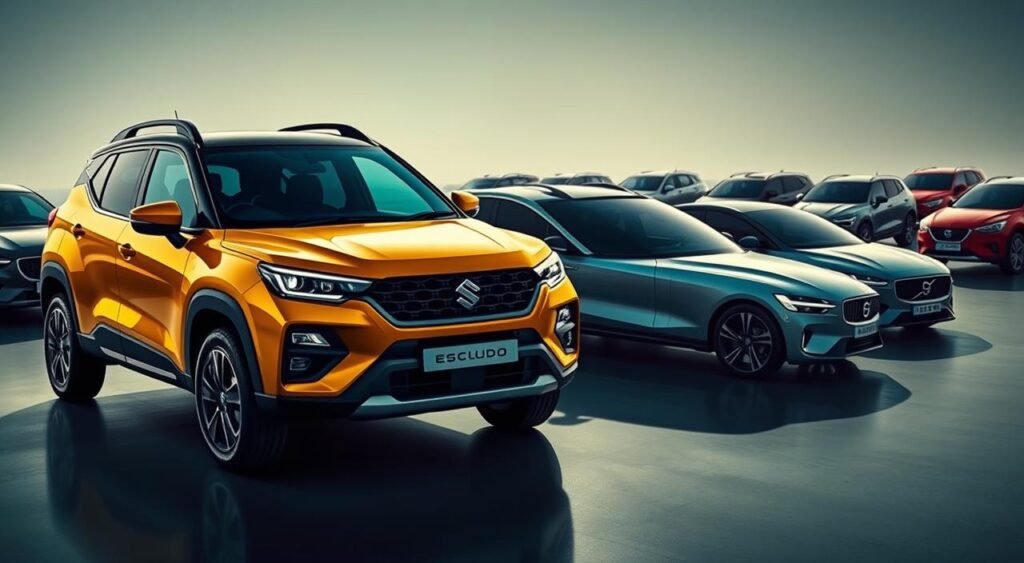
Citroen introduces the Basalt X on September 5 at Rs 14.13 lakh. It has a black finish, ambient lighting, and a 10.2-inch touchscreen. It offers two engine options.
The Mahindra Thar facelift arrives late September at Rs 12 lakh. It features circular LED headlights and a 10.25-inch touchscreen with a digital driver display.
Market Impact and Anticipated Trends
These new releases mark significant changes in India’s car market. VinFast’s electric vehicles add to the EV competition. Citroen and Mahindra focus on upgrading popular models.
The prices range from Rs 12 lakh to Rs 50 lakh. This shows manufacturers are aiming at various segments.
| Model | Starting Price | Key Feature | Launch Date |
|---|---|---|---|
| VinFast VF6 | Rs 25 lakh | 410 km electric range | September 6 |
| VinFast VF7 | Rs 50 lakh | 496 km electric range | September 6 |
| Citroen Basalt X | Rs 14.13 lakh | Black edition styling | September 5 |
| Mahindra Thar | Rs 12 lakh | LED headlights upgrade | Late September |
These updates show a focus on both electric and traditional cars. The variety in options ensures there’s something for everyone in September 2025.
Industry Reactions and Expert Reviews
The car world is buzzing with the 2025 lineup. VinFast is making waves in India with the VF6 and VF7. Their move to Tamil Nadu shows they’re serious about making cars locally.
Initial Impressions from Automotive Experts
Top car critics are talking about Maruti’s new SUV. It fills a gap between the Brezza and Grand Vitara. The Mahindra Thar facelift is also getting attention, coming four years after its debut.
Volvo EX30 is seen as a great deal in the Rs 40-42 lakh range. It makes electric luxury cars more affordable for Indians.
Consumer Anticipations and Feedback
People are excited about the new cars. Citroen’s Basalt X bookings started at Rs 11,000, showing strong interest. Social media is full of:
- VinFast’s EV prices
- Mahindra Thar’s updates
- Maruti’s SUV options
- Volvo EX30’s value
| Brand | Model | Consumer Interest Level | Key Attraction |
|---|---|---|---|
| VinFast | VF6/VF7 | High | New EV technology |
| Maruti | New SUV | Very High | Segment positioning |
| Mahindra | Thar Facelift | High | Design refresh |
| Volvo | EX30 | Moderate | Premium EV value |
Environmental Considerations in New Models
The car industry is getting greener, thanks to new car news in September 2025. Companies are making cleaner cars to fight climate change. This month, they show they care about the planet with new, eco-friendly ways.
How Brands Address Sustainability in 2025
Big car makers are going green in their own ways. VinFast is a leader with its factory in Tamil Nadu. It cuts down on carbon by making cars closer to where they’re sold.
Maruti is also making a big push with the Escudo. It offers:
- Mild-hybrid tech for better gas use
- Strong hybrid to cut emissions by up to 40%
- CNG option for cleaner burning

Electric and Hybrid Options Available
New cars are getting a big boost from electric power. Three electric cars lead the charge in September:
| Model | Range (km) | Charging Time |
|---|---|---|
| VinFast VF6 | 410 | 27 minutes (10-70%) |
| Volvo EX30 | 480 | 26 minutes (10-80%) |
| VinFast VF7 | 496 | 31 minutes (10-70%) |
These cars can go far on a single charge. They charge up fast, so you don’t wait long. There are also hybrid and CNG options for those who want to help the planet but aren’t ready for electric.
Conclusion and Future Expectations
The September 2025 car launches are a big deal for the Indian car market. Prices range from Rs 9.7 lakh for the Maruti Escudo to Rs 50 lakh for premium cars. This shows makers are trying to meet every customer’s needs during the festive season.
The Future of the Auto Industry Beyond September 2025
VinFast is coming to India, bringing electric cars to the market. Their prices might make more people choose electric cars in big cities. Mahindra and Maruti are also changing their SUVs to fit what people want now.
This change shows the car world is moving towards green cars but keeping prices low. Volvo and others are making electric cars more affordable. This means customers have more choices, even as rules get stricter on pollution.
Final Thoughts on This Month’s Exciting Launches
September 2025 car launches show the Indian car world is ready to change and grow. Each car meets different needs, from city driving to off-road adventures. These new cars will raise the bar for quality, tech, and value in the future.
FAQ
What are the major car debuts expected in September 2025?
September 2025 will see six big car launches. Maruti Suzuki’s new SUV hits the market on September 3. VinFast VF6 and VF7 electric models debut on September 6. Citroen Basalt X is set for September 5. The Mahindra Thar facelift and Volvo EX30 are expected by the end of the month.
What is the price range for the new car releases in September 2025?
The new cars will range from Rs 9.7 lakh to Rs 50 lakh. This covers a wide range of budgets, making something for everyone.
Which electric vehicles are launching in September 2025?
Three electric cars are launching. VinFast VF6 and VF7 offer ranges of 410 km and 496 km. The Volvo EX30 boasts a 480 km WLTP-claimed range, pushing for green mobility.
What are the key features of the Maruti Escudo?
The Maruti Escudo has a panoramic sunroof and ventilated front seats. It also comes with six airbags, a 360-degree camera, and possibly ADAS. It offers mild-hybrid, strong hybrid, and CNG options.
When can customers book the latest car models launching in September?
Citroen Basalt X bookings are open at Rs 11,000. Other brands will announce booking dates closer to their launch in September.
What safety features are included in the Volvo EX30?
The Volvo EX30 has seven airbags and a 360-degree camera system. It also includes Advanced Driver Assistance Systems (ADAS), ensuring top safety.
Which car news September 2025 relates to local manufacturing?
VinFast’s VF6 and VF7 will be made in Tamil Nadu. This shows VinFast’s commitment to local production in India, cutting down on carbon footprint.
What are the expected automotive industry updates regarding the Mahindra Thar?
The updated Mahindra Thar is expected by end-September at Rs 12 lakh. It features Roxx-inspired design and tech like circular LED headlights and a 10.25-inch touchscreen. It keeps its petrol-diesel engines and offers RWD and 4WD options.
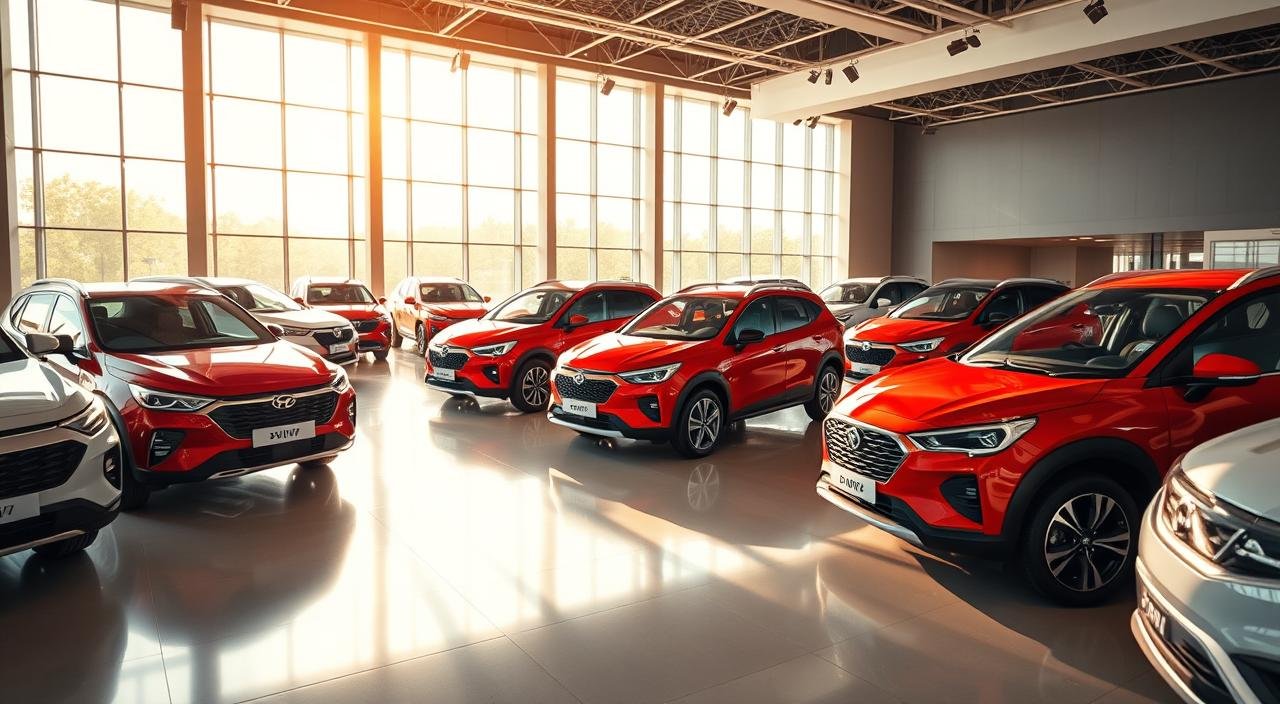
Oct
Did August 2025 see the most diverse month for car launches in India? The month saw cars priced from Rs 5.76 lakh to Rs 1.35 crore. This change marked a big shift in the automotive world.
August 2025 brought a wide range of new cars to India. Brands like Mercedes-AMG and Renault made big updates. SUVs were the most popular, making up 65% of all new cars.
New cars in India 2025 show what buyers want. Electric and hybrid cars made up 10% of the launches. The Renault Kiger Facelift was launched at Rs 6.29 lakh, and the Mercedes-AMG CLE 53 Coupe was priced at Rs 1.35 crore.
The latest cars in India came with new tech and safety features. The Renault Kiger got LED projector headlamps and a unique 10-slat grille. Mercedes-AMG’s CLE 53 Coupe had a 3-litre engine, making 450 PS and going from 0 to 100 kmph in 4.2 seconds.
Key Takeaways
- August 2025 saw a wide range of car launches from Rs 5.76 lakh to Rs 1.35 crore
- SUVs were the most popular, making up 65% of all new cars
- Electric and hybrid vehicles made up 10% of all launches
- Renault Kiger Facelift started at Rs 6.29 lakh with new features
- Mercedes-AMG CLE 53 Coupe was the top luxury car at Rs 1.35 crore
- Performance models had engines making up to 450 PS power
- There were cars for all budgets, from entry-level to premium
Overview of the Automotive Market in India in August 2025
The Indian car market saw big changes in August 2025. New models were released that show what people want to buy. These *top car releases August 2025* had special editions and new looks for different prices.

Black-themed cars were very popular in the *upcoming vehicles India 2025* lineup. Nissan brought out the Magnite Kuro Edition for Rs 7.6-9.94 lakh. It had cool black styling.
Maruti Suzuki also had the Grand Vitara Phantom Blaq Edition in matte black. The Mahindra BE 6 Batman Edition was a special edition, limited to 999 units at Rs 27.79 lakh. It showed the trend of dark colors.
Recent Trends Influencing Car Launches
Anniversary editions were another big thing in *car industry news* this month. Brands celebrated big years with special models. These models were unique and attracted collectors and fans.
Car makers focused on looks over performance. This way, they could offer new cars without spending a lot on changes.
Key Manufacturers and Their Strategies
Big car makers had different plans to win more customers. Renault updated their cars with new looks but kept prices low. Mercedes-AMG went for high-end models.
Citroën added the C3X to their affordable range starting at Rs 7.91 lakh. Toyota let dealers customize the Camry Sprint Edition at Rs 47.48 lakh. BMW introduced special editions of the 330Li and M340i, each limited to 50 units.
Major Launches of August 2025
August 2025 was a big month for automobile releases India in many areas. The car world showed off new electric cars, fancy SUVs, and useful small cars. This in-depth car launch coverage talks about the top models that caught people’s eyes.
Spotlight on Electric Vehicles
The electric car world shone bright with Mahindra’s BE 6 Batman Edition leading the way. It has a big 79kWh battery and a strong 286 PS electric motor. It can go 683 km on one charge, making it a top pick for 2025.
This special edition has two 12.9-inch screens and a top-notch 16-speaker Harman Kardon sound system. It also has advanced safety features for everyone inside.
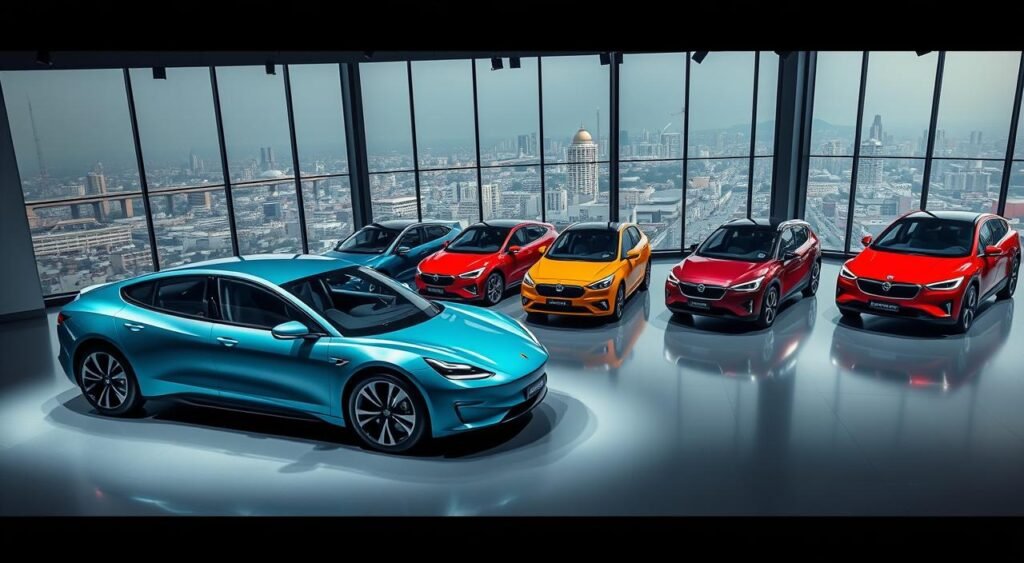
Notable Launches in the SUV Segment
SUVs were big in automobile releases India this month. The Citroën C3X came with cool LED lights and a big 10.25-inch screen. It’s priced well from Rs 7.91 lakh and has automatic climate control.
Maruti Suzuki marked Nexa’s 10th year with the Grand Vitara Phantom Blaq edition. This special model has:
- Black-themed interiors with champagne-gold accents
- Premium leatherette upholstery
- A 1.5-litre three-cylinder strong-hybrid engine producing 116 PS
Compact Cars Making Waves
The small car world saw exciting updates in best new cars 2025. Renault’s Kiger Facelift has two engine choices – a 72 PS 1-litre and a 100 PS turbo-petrol. It comes with manual, AMT, and CVT transmissions, and costs up to Rs 11.29 lakh.
Nissan brought the Magnite Kuro Edition for those who love style. It has a black grille, 16-inch wheels, and piano-black inside. But it keeps the same specs as the regular models.
Featured Models from Popular Brands
The latest car models in India show off innovation from top makers. August 2025 brings new updates from brands like Toyota, Honda, and Hyundai. Each has unique features and prices that stand out.
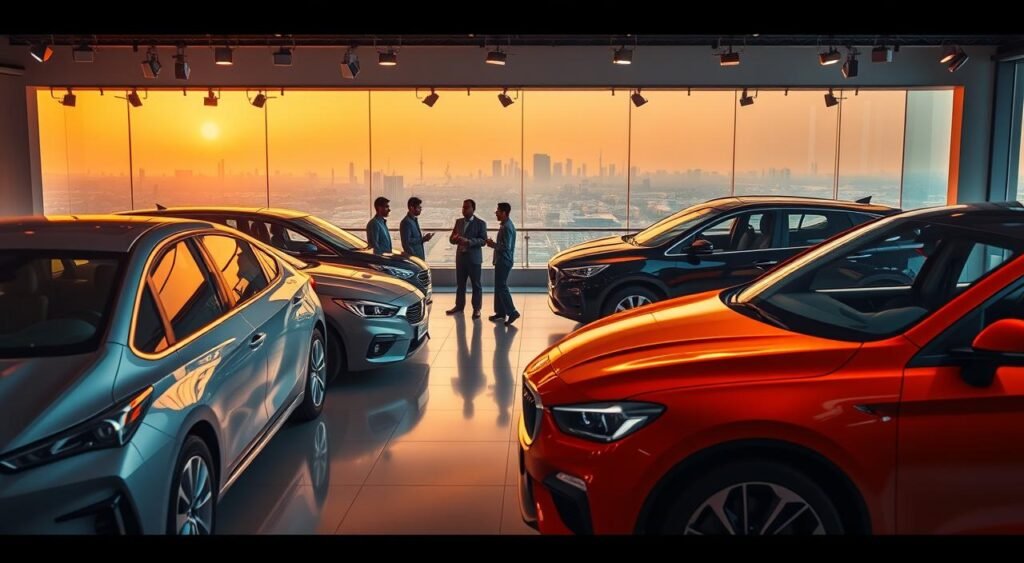
Toyota’s Latest Offerings
Toyota introduces the Camry Sprint Edition for Rs 48.50 lakh. It has a matte black hood and roof and blackout alloys. The interior shines with ambient lighting and door warning lights.
Key features include:
- Triple-zone climate control for enhanced comfort
- Premium JBL speaker system
- 12.3-inch digital driver’s display
- 230 PS 2.5-litre strong-hybrid powertrain
Honda’s Innovative Designs
Honda was a bit quiet in August 2025, but they’re working on new models. They’re making cars just for Indian buyers, with big plans for the future.
New Entries from Hyundai
Hyundai celebrates the Creta’s 10-year mark with three special editions. The King, King Knight, and King Limited cost from Rs 17.27 to 20.20 lakh. They come with different engine options.
The second-generation Venue is coming on August 24. It will have:
- Redesigned grille with rectangular inserts
- Split headlamp arrangement with full-width LED light bar
- Refreshed dashboard with larger touchscreen
- Digital instrument cluster and panoramic sunroof
- Dual-zone climate control
Performance and Features Highlight
The top car releases in August 2025 bring new tech and better performance. Indian and global brands have raised the bar. They offer faster, safer, and more efficient cars. These changes meet the needs of today’s car buyers who want quality at good prices.
Advanced Technology Introduced
The Mercedes-AMG CLE 53 has a top-notch sound system and memory seats. It also has advanced safety features that let it go up to 270 kmph. The Citroën C3X adds wireless tech for music and maps, along with a cool digital display and charging ports.

Safety Features to Note
Car news shows more safety features in all price ranges. The Mahindra BE 6 has smart cruise control and lots of airbags. It even has Batman-themed customization without losing safety. These features are now common in new cars coming to India in 2025.
Fuel Efficiency Improvements
Hybrid cars are getting better at saving fuel. The Toyota Camry Sprint uses a special gearbox for better hybrid power. The Maruti Grand Vitara Phantom Blaq gets better gas mileage with its hybrid engine. The BMW X5 M Sport Pro and Renault Kiger also offer good fuel economy.
Pricing and Availability Information
The August 2025 car releases in India showed a wide range of prices. The cheapest cars started at Rs 5.76 lakh, while the most expensive reached Rs 1.35 crore. Every category had something for everyone, with different prices in different places.
Price Ranges for New Models
Renault Kiger’s starting price of Rs 5.76 lakh was a hit with budget shoppers. The compact SUV market was fierce, with prices like Citroën C3X from Rs 7.91-10.15 lakh and Nissan Magnite Kuro Edition from Rs 7.6-9.94 lakh. These cars are perfect for first-time buyers looking for a good deal.
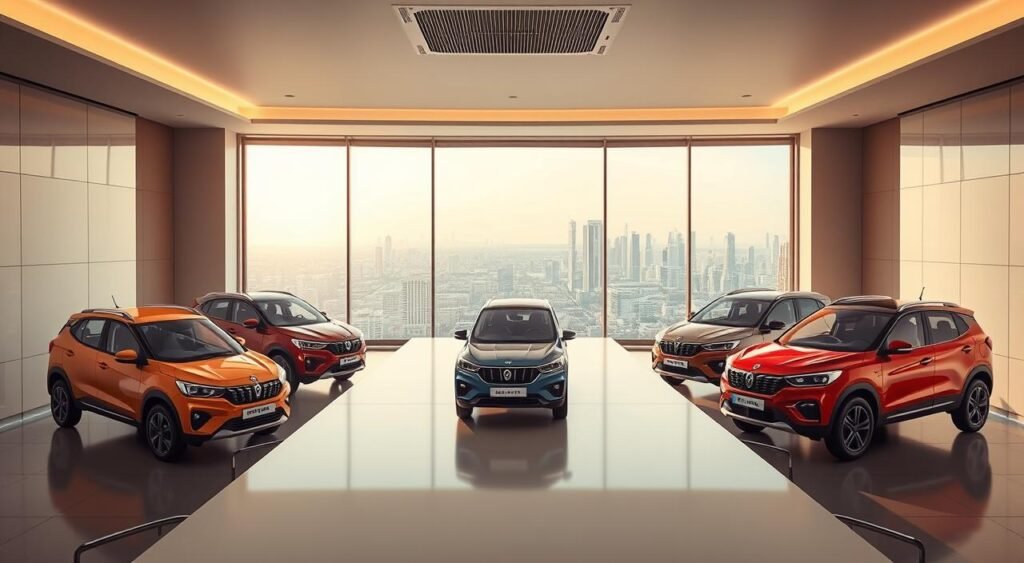
For those looking for something more, Hyundai Creta special editions were priced at Rs 17.27-20.20 lakh. Luxury seekers could consider the BMW 330Li at Rs 64 lakh or the exclusive M340i 50 Jahre Edition at Rs 76.90 lakh. The top of the line was the BMW X5 M Sport Pro petrol at Rs 1.13 crore and diesel at Rs 1.15 crore. Mercedes-AMG CLE 53 was the priciest at Rs 1.35 crore.
Expected Availability Dates
Renault Kiger facelift hit the market on August 24. Mahindra BE 6 Batman Edition will start deliveries on September 20, International Batman Day. Limited production made these cars hot items. BMW’s anniversary editions were made in just 50 units each. Skoda’s 25th anniversary models were capped at 500 units. The Mahindra BE 6 Batman Edition’s 999 units sold out fast.
Regional Variations in Pricing
Prices varied by state due to local taxes and fees. Customization packages at dealerships added to the cost. For example, the Maruti Grand Vitara Phantom Blaq package cost Rs 1.05 lakh extra. Big cities paid 3-5% more than smaller cities.
| Model | Base Price (Rs) | Top Variant (Rs) | Availability |
|---|---|---|---|
| Renault Kiger | 5.76 lakh | 8.99 lakh | August 24 |
| Citroën C3X | 7.91 lakh | 10.15 lakh | Immediate |
| Nissan Magnite Kuro | 7.6 lakh | 9.94 lakh | Immediate |
| Hyundai Creta SE | 17.27 lakh | 20.20 lakh | Immediate |
| BMW 330Li | 64 lakh | 64 lakh | Limited Stock |
Conclusion and Future Outlook for Car Launches
The car world in India is changing fast. Car makers are using new tech and listening to what people want. The latest cars in August 2025 show a big move towards electric cars and cool features. Brands are bringing out new models in all kinds of categories.
Emerging Trends to Watch For
Electric cars are leading the way with the Maruti Suzuki e Vitara coming soon. It has big batteries for long drives and lots of power. It’s set to take on MG Windsor and Hyundai Creta Electric.
There are also special editions and anniversary models. These show how car makers use uniqueness and history to sell cars.
Anticipated Launches in the Coming Months
September will see more new cars in India, just in time for the festivals. Tata is bringing back the Sierra with electric and gas options. It has a unique design and lots of screens inside.
VinFast is also coming to India with electric SUVs. Maruti Suzuki has a new car, the Escudo, ready for September 3, 2025. It will have different kinds of engines to compete with other SUVs.
FAQ
What were the most significant new car launches in India during August 2025?
August 2025 saw exciting new cars hit the market. The Renault Kiger Facelift started at Rs 6.29 lakh. Mercedes-AMG CLE 53 Coupe was priced at Rs 1.35 crore.
FAQ
What were the most significant new car launches in India during August 2025?
August 2025 saw exciting new cars hit the market. The Renault Kiger Facelift started at Rs 6.29 lakh. Mercedes-AMG CLE 53 Coupe was priced at Rs 1.35 crore.
Which electric vehicles were launched in August 2025?
FAQ
What were the most significant new car launches in India during August 2025?
August 2025 saw exciting new cars hit the market. The Renault Kiger Facelift started at Rs 6.29 lakh. Mercedes-AMG CLE 53 Coupe was priced at Rs 1.35 crore.
FAQ
What were the most significant new car launches in India during August 2025?
August 2025 saw exciting new cars hit the market. The Renault Kiger Facelift started at Rs 6.29 lakh. Mercedes-AMG CLE 53 Coupe was priced at Rs 1.35 crore.
What are the price ranges for the latest car models in India?
FAQ
What were the most significant new car launches in India during August 2025?
August 2025 saw exciting new cars hit the market. The Renault Kiger Facelift started at Rs 6.29 lakh. Mercedes-AMG CLE 53 Coupe was priced at Rs 1.35 crore.
FAQ
What were the most significant new car launches in India during August 2025?
August 2025 saw exciting new cars hit the market. The Renault Kiger Facelift started at Rs 6.29 lakh. Mercedes-AMG CLE 53 Coupe was priced at Rs 1.35 crore.
Which brands focused on anniversary or special editions in August 2025?
FAQ
What were the most significant new car launches in India during August 2025?
August 2025 saw exciting new cars hit the market. The Renault Kiger Facelift started at Rs 6.29 lakh. Mercedes-AMG CLE 53 Coupe was priced at Rs 1.35 crore.
FAQ
What were the most significant new car launches in India during August 2025?
August 2025 saw exciting new cars hit the market. The Renault Kiger Facelift started at Rs 6.29 lakh. Mercedes-AMG CLE 53 Coupe was priced at Rs 1.35 crore.
What transmission options are available in the new Renault Kiger Facelift?
FAQ
What were the most significant new car launches in India during August 2025?
August 2025 saw exciting new cars hit the market. The Renault Kiger Facelift started at Rs 6.29 lakh. Mercedes-AMG CLE 53 Coupe was priced at Rs 1.35 crore.
FAQ
What were the most significant new car launches in India during August 2025?
August 2025 saw exciting new cars hit the market. The Renault Kiger Facelift started at Rs 6.29 lakh. Mercedes-AMG CLE 53 Coupe was priced at Rs 1.35 crore.
Are there any upcoming vehicles India 2025 buyers should anticipate?
FAQ
What were the most significant new car launches in India during August 2025?
August 2025 saw exciting new cars hit the market. The Renault Kiger Facelift started at Rs 6.29 lakh. Mercedes-AMG CLE 53 Coupe was priced at Rs 1.35 crore.
FAQ
What were the most significant new car launches in India during August 2025?
August 2025 saw exciting new cars hit the market. The Renault Kiger Facelift started at Rs 6.29 lakh. Mercedes-AMG CLE 53 Coupe was priced at Rs 1.35 crore.
What advanced features do the top car releases August 2025 offer?
FAQ
What were the most significant new car launches in India during August 2025?
August 2025 saw exciting new cars hit the market. The Renault Kiger Facelift started at Rs 6.29 lakh. Mercedes-AMG CLE 53 Coupe was priced at Rs 1.35 crore.
FAQ
What were the most significant new car launches in India during August 2025?
August 2025 saw exciting new cars hit the market. The Renault Kiger Facelift started at Rs 6.29 lakh. Mercedes-AMG CLE 53 Coupe was priced at Rs 1.35 crore.
How did the automobile releases India market perform in terms of segment distribution?
FAQ
What were the most significant new car launches in India during August 2025?
August 2025 saw exciting new cars hit the market. The Renault Kiger Facelift started at Rs 6.29 lakh. Mercedes-AMG CLE 53 Coupe was priced at Rs 1.35 crore.
Oct
Kia Corporation has mixed the practicality of an MPV with the style of an SUV. This has led to two new models that will change India’s car scene.
The Kia Carens Clavis Revealed is a big step in India’s car market. It starts at Rs. 11.50 Lakh and comes in 24 variants. It has both petrol and diesel engines and various transmission options.
Kia has also introduced the Carens Clavis EV, India’s first electric car from Kia. It has two battery sizes and can go up to 490 kilometers on a single charge.
Both models are made at Kia’s top-notch factory in India. They show Kia’s dedication to making cars for everyone. The Carens combines SUV looks with MPV practicality, perfect for Indian families.
Key Takeaways
- Kia Carens Clavis MPV starts at Rs. 11.50 Lakh with 24 variants available
- First made-in-India electric vehicle from Kia with up to 490 km range
- Multiple transmission options including manual, automatic DCT, and clutchless manual
- Both petrol and diesel engine options for diverse customer preferences
- Manufactured at Kia’s Indian facility showing local production skills
- SUV-inspired design merged with MPV practicality for lifestyle-oriented buyers
Overview of the Kia Carens Clavis
The Kia Carens Clavis is a big step forward in the MPV world. It brings new tech and design to family cars. This car is all about making driving better with its mix of useful features and luxury.

What Makes the Carens Clavis Stand Out?
The Kia Carens Clavis has a cool feature: two 12.3-inch screens for info and gauges. This setup makes driving feel like a premium experience. You can also get a big sunroof to let in lots of light.
New beige and navy blue upholstery adds a fancy feel to the inside. It’s perfect for those who want style and comfort.
Key Specifications and Features
The Kia Carens has great size and power options for all kinds of drivers:
| Dimension | Measurement |
|---|---|
| Length | 4,550 mm |
| Width | 1,800 mm |
| Height | 1,708-1,730 mm |
| Wheelbase | 2,780 mm |
| Seating Options | 6 or 7 seats |
There are different engines to choose from:
- 1.5L naturally aspirated petrol: 113 bhp with 144 Nm torque
- 1.5L turbo-petrol: 158 bhp with 253 Nm torque
- 1.5L diesel: 114 bhp with 250 Nm torque
- Electric variants: 99kW/225Nm or 126kW/255Nm options
This review shows off the car’s cool features. You get wireless charging, lots of USB ports, and a 360-degree camera. The steering wheel is sporty but also comfy for long drives.
Bold Exterior Design Elements
The Kia Carens has a bold design that makes it stand out. It’s made to catch the eye on Indian roads. It combines sporty looks with smart details for families who want both style and function.
Sleek Lines and Contemporary Style
The Kia Carens has connected DRLs and unique lamps that grab attention. A silver skid plate adds a touch of luxury and protects the bumper. New bumpers and black cladding give it a sleek look.
The air dam adds beauty and boosts aerodynamics. Its LED headlamps and rear light bar create a unified look.
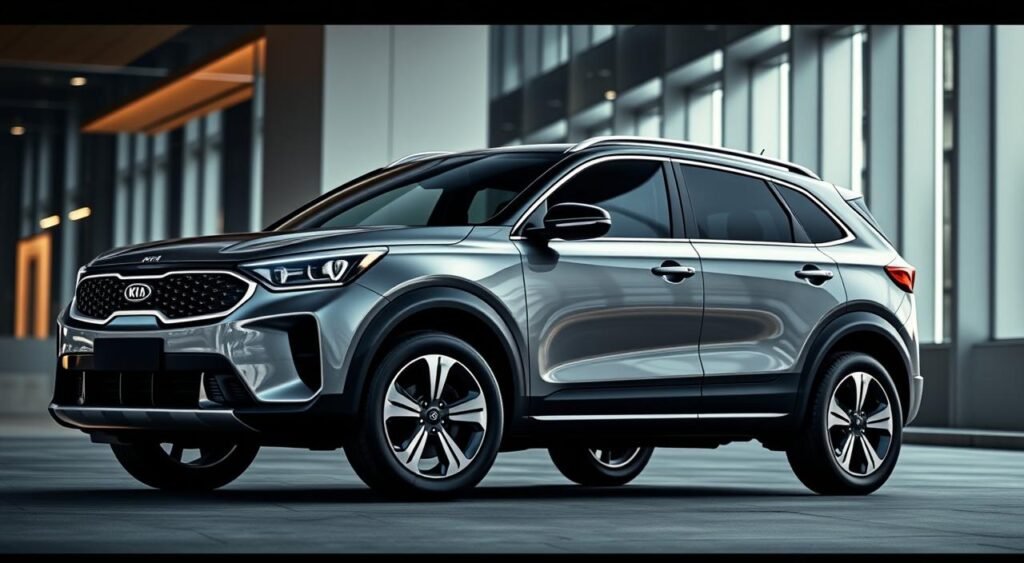
Innovative Lighting Solutions
The Kia Carens lights are a step ahead in tech. Its LED tail lights are modern and bright. They make the car easy to spot at night.
The EV model has special lights that show it’s electric. Yet, it keeps the bold design.
Color Options and Customization
There are six colors to choose from for the Kia Carens:
| Color Option | Finish Type | Best Suited For |
|---|---|---|
| Clear White | Solid | Classic elegance |
| Glacier White Pearl | Pearl | Premium appeal |
| Aurora Black | Pearl | Sporty character |
| Gravity Gray | Metallic | Urban sophistication |
| Imperial Blue | Metallic | Dynamic presence |
| Sparkling Silver | Metallic | Timeless style |
The side has new 17-inch alloy wheels and silver roof rails. The EV model has a special grille and charging port. It also has aero-dynamic wheels that boost efficiency without losing its bold design look.
Luxurious Interior Features
The Kia Carens Clavis raises the bar for luxury interiors in its class. Inside, you’ll find a cabin that rivals top sedans with its elegant design and fine details. Every part shows off careful craftsmanship, making both daily drives and long trips a pleasure.
Premium Materials and Comfort
The Carens stands out with its high-quality materials. It has ventilated front seats for cool comfort in warm weather. The driver’s seat adjusts with manual controls for height, recline, and slide.
New beige and navy blue upholstery options let buyers choose their style. This adds a personal touch to the interior.
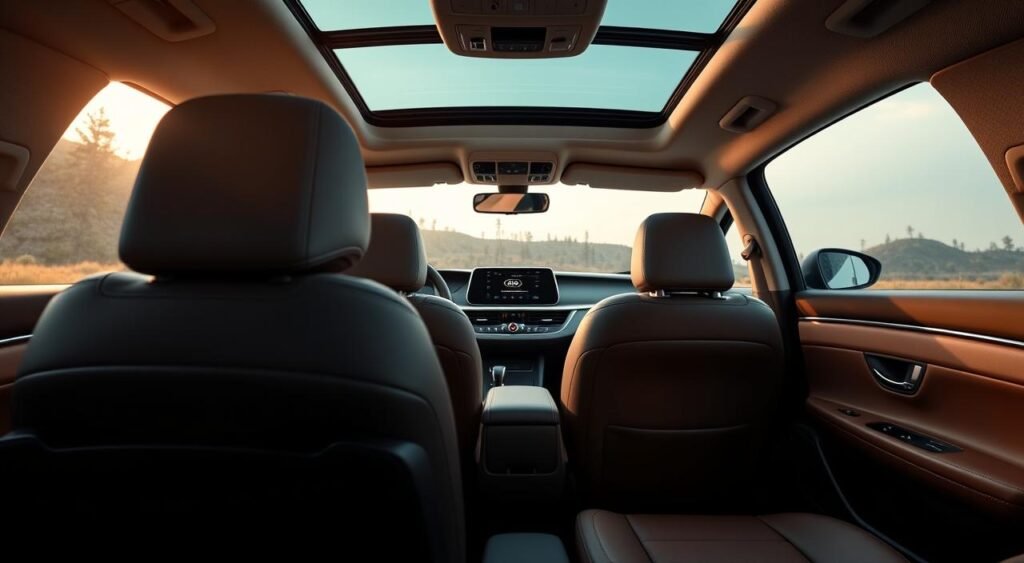
Advanced Technology Integration
Technology is at the forefront with the 26.62-inch Dual Panoramic Display. This huge screen controls all vehicle functions. The 8-speaker Bose audio system brings concert-quality sound to the cabin.
A Smart Pure Air Purifier keeps air clean, and 64-color ambient lighting sets the mood. These features make every drive special.
Space and Versatility for Families
The Kia Carens is perfect for families with its flexible seating. The third row folds and reclines for comfort. Second-row seats tumble with Boss Mode for extra legroom.
Independent slide and recline of middle row seats add to the convenience. Rear sunshades and folding tables make trips easier. The dual-pane sunroof brings in natural light, and the center console has ambient lighting.
With 216 liters of boot space, the Carens handles daily cargo needs well.
Performance and Efficiency
The Kia Carens Clavis offers great performance with its different engines. Each engine balances power and fuel use well. This makes the Kia Carens good for city driving and long trips.
Engine Options and Capabilities
The Kia Carens has three engine types. The base engine is a 1.5-liter petrol that makes 113 horsepower and 144 Nm of torque. For more power, there’s a 1.5-liter turbo-petrol engine that makes 158 horsepower and 253 Nm of torque. It goes from 0-100 km/h in 8.4 to 9.5 seconds.
The diesel engine is a 1.5-liter unit that makes 114 horsepower and 250 Nm of torque. You can choose from several transmissions, including manual, automatic, iMT, and DCT. The electric version has the same acceleration as the turbo-petrol and reaches 166 km/h.

Fuel Economy Ratings
The Kia Carens is also fuel-efficient, which is important for its price. The turbo-petrol engines get between 15.95 and 16.66 kmpl. Diesel engines do even better, getting 17.5 to 19.54 kmpl. This makes the Kia Carens a smart choice for everyday driving.
Driving Experience and Handling
The electric version has i-Pedal 2.0 technology with four regenerative braking levels. You can control these levels with paddle shifters. Auto Mode adjusts regeneration based on traffic.
The liquid-cooled battery pack and Active Air Flap system keep the car at the right temperature. This ensures the car performs well in all driving conditions.
Technology and Safety Innovations
The Kia Carens Clavis introduces cutting-edge tech that sets new standards. It combines smart connectivity with safety systems for peace of mind. The model offers premium features, making it a rival to luxury vehicles while staying practical.
Infotainment System Highlights
The Carens Clavis has over 90 connected car features. It connects to more than 11,000 charging points across India for the EV variant. Digital Key 2.0 lets you unlock your car with your phone, and voice commands control functions without hands off the wheel.
Regular updates keep the system fresh with new features. The AI-powered digital manual answers vehicle questions instantly. Live video consultations connect owners with Kia experts when needed. Pre-emptive maintenance alerts keep your vehicle in top shape.
Advanced Driver Assistance Features
Level 2 ADAS technology brings over 20 autonomous driving functions. Smart Cruise Control keeps a safe distance in traffic. Lane Keeping and Following Assist help drivers stay on course on highways.
Forward Collision-Avoidance Assist detects cars, pedestrians, cyclists, and junctions to prevent accidents. Blind Spot Collision Warning and Avoidance systems monitor areas drivers can’t see. Rear Cross Traffic Collision-Avoidance protects during reverse maneuvers in parking lots.
Driver Attention Warning alerts tired drivers to take breaks. High Beam Assist adjusts headlights for oncoming traffic. The Surround View Monitor offers a 360-degree view for easy parking.
Award-Winning Safety Ratings
Safety is a top priority with 18 standard features. Six airbags and Electronic Stability Control protect all occupants. Hill Assist Control prevents rollback on inclines, and Downhill Brake Control manages speed on steep descents.
ISOFIX child seat anchors secure young passengers properly. Rollover sensors activate protection systems if needed. Anti-lock Braking System with Electronic Brake-force Distribution ensures controlled stops. Tire Pressure Monitoring System alerts drivers to low pressure conditions.
The EV variant has an IP67-certified battery pack for water and dust protection. Vehicle-to-Load capability transforms the Carens into a mobile power source for camping equipment or emergency situations.
FAQ
What is the starting price of the Kia Carens Clavis?
The Kia Carens Clavis MPV starts at Rs. 11.50 Lakh. It comes in 24 variants. You can choose from petrol and diesel engines and different transmissions.
What are the dimensions of the Kia Carens Clavis?
The Kia Carens Clavis is 4,550mm long, 1,800mm wide, and 1,708-1,730mm tall. It has a 2,780mm wheelbase. It’s available in 6 or 7-seater options for different family sizes.
What engine options are available for the Kia Carens Clavis?
The Kia Carens Clavis has three engine options. A 1.5L naturally aspirated petrol engine, a 1.5L turbo-petrol engine, and a 1.5L diesel engine. The EV variant has two motor outputs.
What is the range of the Kia Carens Clavis EV?
The Kia Carens Clavis EV has a range of up to 490 km. It comes with 42 kWh or 51.4 kWh battery packs. It also has intelligent regeneration and four levels of regenerative braking.
What are the key interior features of the Kia Carens Clavis?
Inside, you’ll find dual 12.3-inch displays and an 8-speaker Bose audio system. It also has 64-color ambient lighting and a Smart Pure Air Purifier. Higher variants include a panoramic sunroof.
Does the Kia Carens Clavis have ADAS features?
Yes, the Kia Carens Clavis has ADAS Level 2. It includes Smart Cruise Control, Lane Keeping/Following Assist, and Forward Collision-Avoidance Assist. It also has Blind Spot Collision Warning/Avoidance and Surround View Monitor.
What are the fuel economy ratings for the Kia Carens Clavis?
The turbo-petrol variants get 15.95-16.66 kmpl. Diesel versions get 17.5-19.54 kmpl. The EV variant accelerates from 0-100 km/h in 8.4-9.5 seconds and has a top speed of 166 kph.
What safety features come standard with the Kia Carens Clavis?
The Kia Carens Clavis has 18 standard safety features. These include six airbags, ESC, HAC, DBC, ISOFIX anchors, rollover sensors, ABS with EBD, and TPMS. It also has Safety Exit Warning/Assist and High Beam Assist.

Aug
Mahindra said yes to India’s 79th Independence Day. They showed off their new NU IQ platform, a big step in car engineering. This new design could change how cars are made.
The Mahindra NU IQ Platform is very flexible. It can support different car styles and engines. Four concept cars show its possibilities: Vision S, Vision X, Vision T, and Vision SXT.
What’s exciting about Mahindra’s new platform is how it can change. It works with gas engines, electric motors, and hybrids. Cars can be small or big, with different wheelbases.
This flexible base is Mahindra’s biggest move yet. It works for cars driven on the right or left side. This makes making cars cheaper and easier.
Key Takeaways
- Mahindra unveiled the NU IQ platform on India’s 79th Independence Day
- The monocoque architecture supports multiple body styles and powertrains
- Four concept vehicles demonstrate the platform’s versatility: Vision S, X, T, and SXT
- Vehicle sizes range from sub-4 meters to 4.5 meters with 2.6-meter wheelbase capability
- The platform accommodates ICE, electric, and hybrid powertrains
- Designed for both right-hand-drive and left-hand-drive markets globally
Overview of Mahindra’s NU IQ Platform
Mahindra has introduced the NU IQ platform, a new multi-energy monocoque architecture. It’s set to change the future of SUV design. This platform is a big step in car engineering, combining the latest tech with practical features.
Concept and Development
The NU IQ Platform was designed with a focus on sophistication. Engineers in Mumbai and Banbury, UK, worked together. They followed Mahindra’s Heartcore design philosophy.
This design keeps SUV values alive while adding modern tech. The platform’s monocoque structure is stronger than old designs. It improves handling and safety without losing SUV toughness.
Key Objectives of the Platform
The Mahindra NU IQ Platform aims to set new SUV standards:
- Get 5-star safety ratings in Global NCAP and Euro NCAP tests
- Keep a high 227mm ground clearance for better off-road driving
- Offer a commanding driving position like premium SUVs
- Be a base for future car models
This plan makes sure the platform’s cars perform well in all conditions. They also meet strict safety rules around the world.
Features of the NU IQ Platform
The Mahindra NU IQ Platform introduces advanced technology to cars. It changes how we drive with smart digital features and practical designs. It’s built for the future, combining cloud tech with easy-to-use interfaces.
Advanced Connectivity Solutions
The platform uses cloud tech for instant data sharing between cars and digital systems. It lets drivers check car info on their phones. The Mahindra NU IQ Platform Details show it works well with smartphones and other devices.
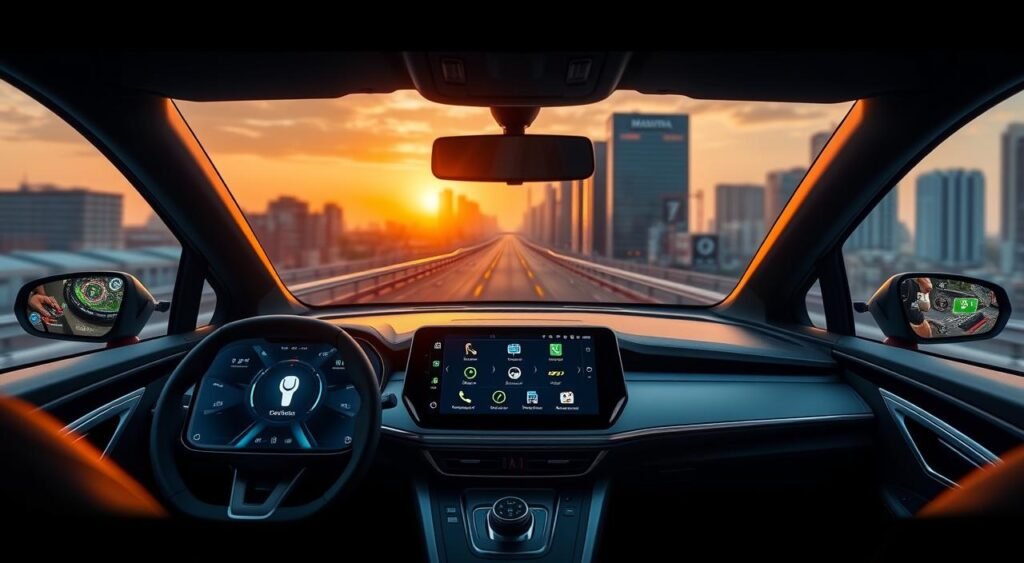
Intelligent Vehicle Management Systems
Managing your car is easy with the platform’s smart systems. You can track performance, schedule maintenance, and get alerts through digital screens. It uses smart algorithms to improve car performance and predict when you might need service.
User-Centric Design Elements
The platform focuses on comfort in its design. The Mahindra NU IQ Platform Information shows it has lots of space for passengers. It has a completely flat floor for more comfort in the back seats.
| Interior Dimension | Measurement |
|---|---|
| Front to Rear Passenger Space | 830 mm |
| Second-Row Legroom | 937 mm |
| Second-Row Shoulder Room | 1,404 mm |
| Boot Capacity (to seatback) | 450 liters |
| Boot Capacity (to roof) | 644 liters |
The platform has a 5-link rear suspension system, like luxury cars. It uses strong materials to protect people and keep the car light. This helps with better fuel use and performance.
Benefits for Consumers
The Mahindra NU IQ Platform Review shows big wins for drivers. It mixes tough SUV features with smooth comfort. This new platform changes how we drive, blending old SUV strengths with new tech.
Enhanced Driving Experience
The NU IQ Platform Guide talks about a great driving spot. It offers clear views and keeps the car strong. It also handles tough trails well, making off-road fun for all.

- 28-degree approach angle for steep inclines
- 28.2-degree breakover angle for navigating obstacles
- 34.9-degree departure angle for confident descents
- 227mm ground clearance for rough terrain
The 5-link rear suspension makes rides smooth on roads and trails. It also has lots of room inside for passengers. This makes long trips comfy for families.
Safety and Security Improvements
Safety is key in the Mahindra NU IQ Platform Review. It aims for top safety ratings in crash tests. This is thanks to high-strength materials and smart design.
The platform uses smart safety tech to protect people. It’s not just about airbags. This makes the NU IQ Platform Guide a must-read for those who care about safety in India’s SUV market.
Impact on the Automotive Industry
The car world is changing fast with new platforms coming up. Mahindra’s NU IQ Platform is a big move that shakes things up. It shows how old car makers can keep up with new needs while staying true to what they do best.
Trends and Innovations
There’s a big trend towards flexible platforms. Mahindra’s NU IQ Platform mixes monocoque construction with real off-road skills. This meets a need in the market for cars that do well in cities and on rough paths.
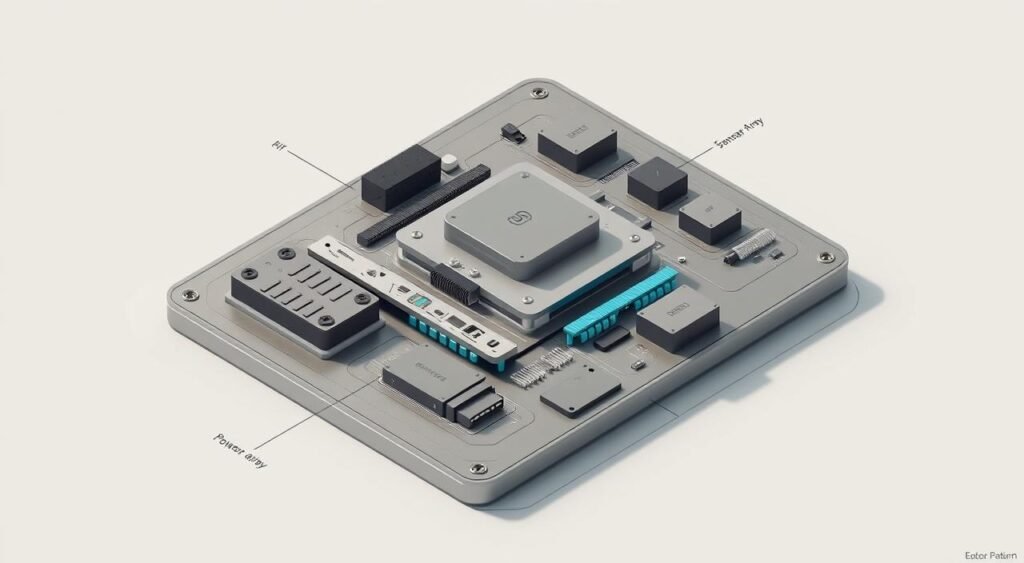
Now, people want cars that can handle different powertrains. The NU IQ Platform fits various body styles in a 4.3 to 4.5-meter range. It’s perfect for the popular compact and mid-size SUVs.
How It Compares to Competitors
Looking at Mahindra’s NU IQ Platform shows how it stands out. It’s different from other monocoque platforms because it’s great for off-road:
| Platform Feature | NU IQ Platform | Typical Monocoque Competitors |
|---|---|---|
| Construction Type | Monocoque with off-road capability | Standard monocoque |
| Off-road Angles | High approach/departure angles | Limited angles |
| Powertrain Options | Multiple configurations | Limited flexibility |
| Target Segment | 4.3-4.5 meter SUVs | Urban-focused designs |
This special spot lets Mahindra stand out in crowded markets. It offers unique features that attract buyers who love adventure.
Sustainability Initiatives
Mahindra’s New NU IQ Platform Explained shows the company’s big commitment to green transport. It’s a big step towards making cars better for the planet. This platform combines different power sources and focuses on reducing harm to the environment.
Environmentally Friendly Technologies
The NU IQ platform uses the latest green tech to cut down on harm to the environment. It supports electric, gas, and hybrid cars all in one. This means no need for different platforms for each type of car.

It uses strong, light materials to make cars more eco-friendly. These materials make cars lighter, which saves fuel and cuts down on emissions. This is good for both electric and gas cars.
Contributions to Green Mobility
Mahindra’s New NU IQ Platform Explained shows how cars can be greener without losing performance. It’s ready for electric cars, which will soon be needed by law.
- Support for multiple battery configurations in electric vehicles
- Optimized aerodynamics for improved energy efficiency
- Recyclable materials integrated into the platform design
- Reduced manufacturing complexity leading to lower production emissions
This design lets Mahindra meet the growing need for green cars. It’s flexible and can keep up with changing rules while staying affordable.
Future Roadmap for NU IQ
Mahindra has big plans for the NU IQ platform. They aim to change their whole vehicle lineup. With four new concept vehicles, Mahindra shows they’re all about innovation and variety.
Upcoming Features and Updates
The Vision S is the star of Mahindra’s NU IQ lineup, set to hit the market in 2027. It’s a compact SUV with a bold design. The Vision X hints at the next XUV 3XO, with smart tech and connectivity.

Two more concepts show the platform’s range. The Vision T is a mix of the Thar E and electric tech. The Vision SXT is a pickup, showing how versatile Mahindra’s platform can be.
Strategic Partnerships and Collaborations
Mahindra is taking a global approach to making the NU IQ platform. Design teams in Mumbai and Banbury, UK, are working together. This mix of Indian insight and global design is setting the stage for global success.
They’re also open to working with tech companies and parts makers. As the platform grows, look for partnerships that will bring new tech and expertise to Mahindra’s lineup.
Conclusion
The Mahindra NU IQ platform brings big changes to car design and making. It’s a new way to build cars that can handle different engines and designs. This makes Mahindra ready to meet the needs of many customers in India and around the world.
Summary of Key Takeaways
This platform has features that Indian buyers love. It has 227mm ground clearance and is great for off-road adventures. The inside is roomy, with up to 644 liters of space for luggage.
It’s also safe, aiming for 5-star crash test ratings. These benefits meet what people want in compact and mid-size SUVs.
Final Thoughts on Mahindra’s Innovation
This launch shows Mahindra is ready to take on big names like Tata Motors and Hyundai. It’s a big step towards electric cars, showing Mahindra’s vision for the future. The Vision S model in 2027 will combine old SUV strengths with new tech.
The Mahindra NU IQ platform will help shape the brand’s future. It will make Mahindra stronger in both regular and electric cars.
FAQ
What are the key features of Mahindra’s NU IQ Platform?
The NU IQ Platform has a unique design. It supports ICE, electric, and hybrid powertrains. It also has 227mm ground clearance and advanced connectivity.
FAQ
What are the key features of Mahindra’s NU IQ Platform?
The NU IQ Platform has a unique design. It supports ICE, electric, and hybrid powertrains. It also has 227mm ground clearance and advanced connectivity.
What benefits does the Mahindra NU IQ Platform offer consumers?
FAQ
What are the key features of Mahindra’s NU IQ Platform?
The NU IQ Platform has a unique design. It supports ICE, electric, and hybrid powertrains. It also has 227mm ground clearance and advanced connectivity.
FAQ
What are the key features of Mahindra’s NU IQ Platform?
The NU IQ Platform has a unique design. It supports ICE, electric, and hybrid powertrains. It also has 227mm ground clearance and advanced connectivity.
How does the NU IQ Platform compare to competitors in the automotive industry?
FAQ
What are the key features of Mahindra’s NU IQ Platform?
The NU IQ Platform has a unique design. It supports ICE, electric, and hybrid powertrains. It also has 227mm ground clearance and advanced connectivity.
FAQ
What are the key features of Mahindra’s NU IQ Platform?
The NU IQ Platform has a unique design. It supports ICE, electric, and hybrid powertrains. It also has 227mm ground clearance and advanced connectivity.
What sustainability features are included in the Mahindra NU IQ Platform?
FAQ
What are the key features of Mahindra’s NU IQ Platform?
The NU IQ Platform has a unique design. It supports ICE, electric, and hybrid powertrains. It also has 227mm ground clearance and advanced connectivity.
FAQ
What are the key features of Mahindra’s NU IQ Platform?
The NU IQ Platform has a unique design. It supports ICE, electric, and hybrid powertrains. It also has 227mm ground clearance and advanced connectivity.
When will vehicles based on the NU IQ Platform be available?
FAQ
What are the key features of Mahindra’s NU IQ Platform?
The NU IQ Platform has a unique design. It supports ICE, electric, and hybrid powertrains. It also has 227mm ground clearance and advanced connectivity.
What are the interior dimensions and cargo capacity of NU IQ Platform vehicles?
FAQ
What are the key features of Mahindra’s NU IQ Platform?
The NU IQ Platform has a unique design. It supports ICE, electric, and hybrid powertrains. It also has 227mm ground clearance and advanced connectivity.
FAQ
What are the key features of Mahindra’s NU IQ Platform?
The NU IQ Platform has a unique design. It supports ICE, electric, and hybrid powertrains. It also has 227mm ground clearance and advanced connectivity.
Is the NU IQ Platform designed for international markets?
FAQ
What are the key features of Mahindra’s NU IQ Platform?
The NU IQ Platform has a unique design. It supports ICE, electric, and hybrid powertrains. It also has 227mm ground clearance and advanced connectivity.
FAQ
What are the key features of Mahindra’s NU IQ Platform?
The NU IQ Platform has a unique design. It supports ICE, electric, and hybrid powertrains. It also has 227mm ground clearance and advanced connectivity.
What safety ratings is Mahindra targeting with the NU IQ Platform?
FAQ
What are the key features of Mahindra’s NU IQ Platform?
The NU IQ Platform has a unique design. It supports ICE, electric, and hybrid powertrains. It also has 227mm ground clearance and advanced connectivity.
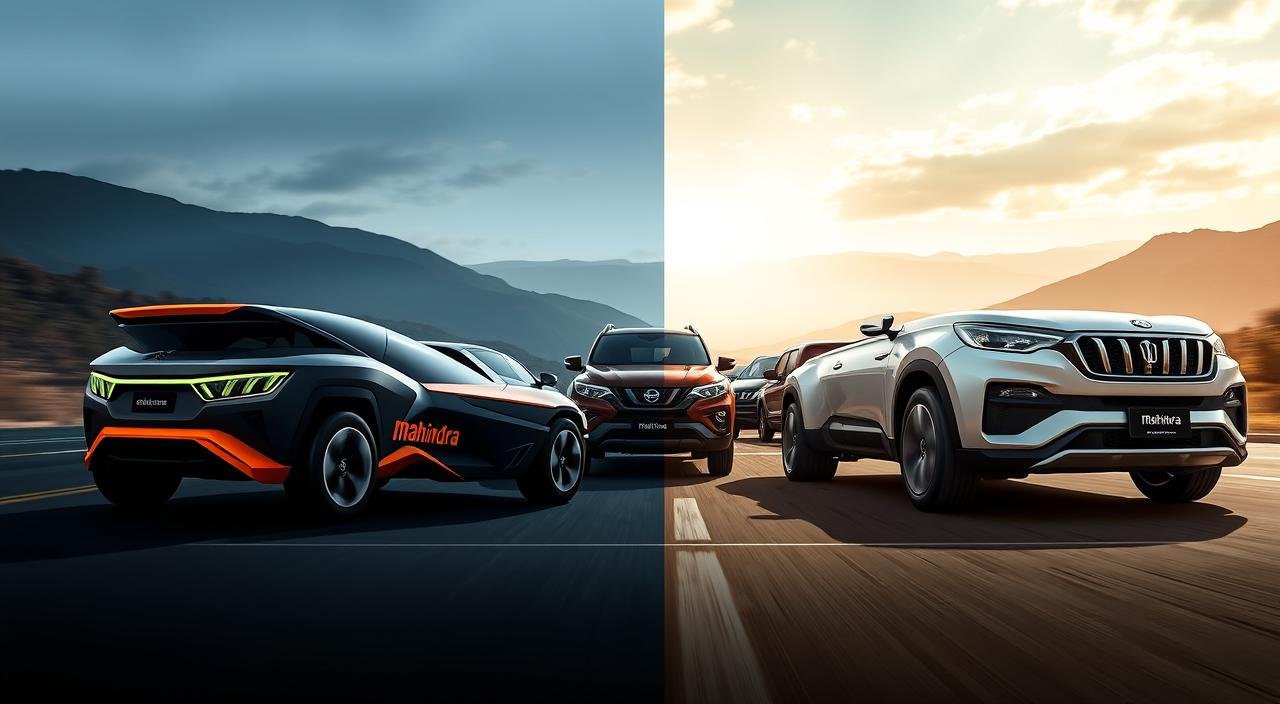
Aug
Mahindra, a giant in the Indian auto world, is at a turning point. Their current SUVs, like the XUV700, are big hits in India. But, their Vision concepts aim to take a huge leap forward.
The Vision.T concept shows Mahindra’s big plans with the Nu IQ platform. It supports both electric and traditional engines. This 5-door SUV keeps the classic look off-road fans love but adds the latest tech.
The XUV700 is a top choice now, with prices from Rs 14.50-25.14 lakh. It comes with 200 PS turbo-petrol and 185 PS diesel engines. It also has cool tech like all-wheel-drive and a panoramic sunroof.
Mahindra’s future models, like the Vision.T, are even more exciting. The interior has a modern dashboard, big screens, and digital displays. A cool steering button adds a touch of modernity. These features show Mahindra’s focus on both function and luxury.
Key Takeaways
- Mahindra Vision.T concept evolves from the Thar E design on the versatile Nu IQ platform
- Current XUV700 offers 200 PS petrol and 185 PS diesel engines with ADAS technology
- Vision concepts support both internal combustion and electric powertrains
- Traditional boxy SUV design meets modern tech in future Mahindra models
- Price range for current lineup spans Rs 14.50-25.14 lakh with premium features
- Interior innovations include vertical touchscreens and digital driver displays
Overview of Mahindra’s Vision Concepts
Mahindra has boldly stepped into the future with its electric vehicle concepts. The Vision.T concept was unveiled on Independence Day. It shows how off-road skills can blend with green tech.
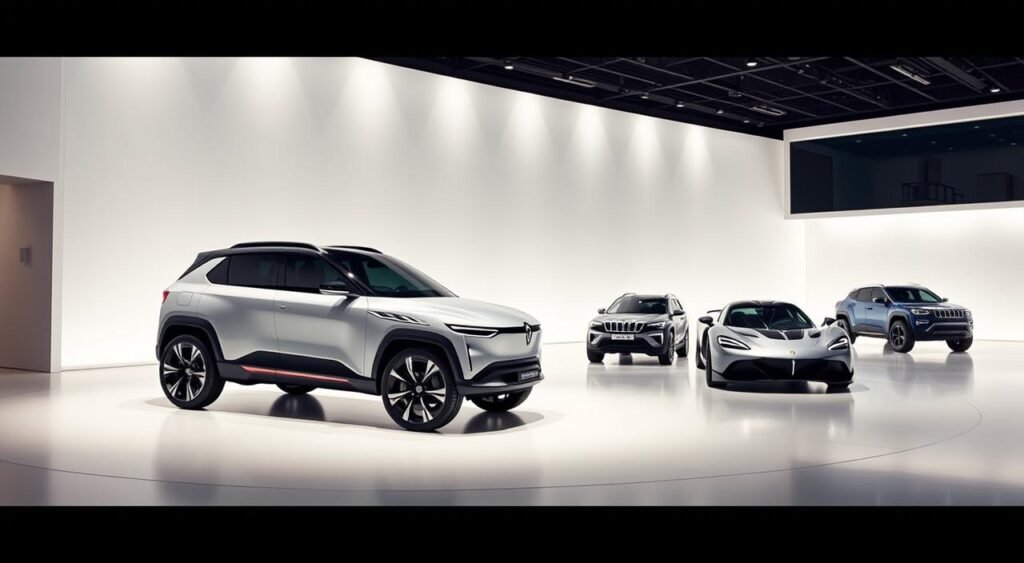
What Are Vision Concepts?
Vision concepts are design studies that hint at future cars. They test new tech and looks. The Vision.T turns the Thar into an electric vehicle, keeping its tough vibe.
Key Features of Mahindra’s Vision Concepts
The Vision.T has some cool design features:
- Six-slat split grille like the Thar Roxx
- Squared headlights with split vertical LED DRLs
- Chunky blacked-out bumper with an exposed yellow tow hook
- Boxy profile with an upright stance
- Rear door handles on the C-pillar
- Tailgate-mounted spare wheel with squared tail lights
Future Trends in SUV Design
This Mahindra SUV Review shows new trends in design. Electric cars are changing SUV looks, allowing for creative interiors. The Vision.T keeps its off-road spirit but uses green materials and smart lights.
Understanding Mahindra’s Current SUV Lineup
Mahindra is a big name in the Indian SUV market. They offer a wide range of vehicles. Each model has advanced tech and strong performance, meeting different customer needs.
From small urban SUVs to big family cars, Mahindra’s SUVs stand out. They have unique features that make them special in the car world.
Popular Models Available in India
The XUV700 is a top choice in Mahindra’s lineup. It has a cool 10.25-inch dual-screen setup for entertainment and car info. It also has connected car tech and climate control for comfort.

Other great models include the Scorpio-N, Thar, and XUV300. Each one is designed for different customers. Prices start at Rs 10 lakh and go up to Rs 27.44 lakh for the top models.
Performance Metrics of Existing SUVs
Mahindra SUVs are known for their power and fuel efficiency. The XUV700 has two engine options: a 200 PS turbo-petrol and a 185 PS diesel. You can choose between manual and automatic transmissions.
| Model | Engine Type | Power Output | Torque | Transmission Options |
|---|---|---|---|---|
| XUV700 | 2.0L Turbo-Petrol | 200 PS | 380 Nm | 6-Speed MT/AT |
| XUV700 | 2.2L Diesel | 185 PS | 450 Nm | 6-Speed MT/AT |
| Scorpio-N | 2.0L Turbo-Petrol | 203 PS | 380 Nm | 6-Speed MT/AT |
| Thar | 2.0L Turbo-Petrol | 150 PS | 320 Nm | 6-Speed MT/AT |
Safety is key with advanced driver assistance systems (ADAS) in premium models. Features like panoramic sunroofs and ventilated seats make driving better. These features help Mahindra compete with Tata Safari and Hyundai Creta.
Comparing Design Philosophies
Mahindra’s SUV design shows a unique mix of future visions and today’s cars. They blend old-school toughness with sleek looks. This makes their vehicles popular in India’s SUV market.
Aesthetic Differences in Vision Concepts
The Vision.T concept is Mahindra’s bold take on SUVs. It keeps the classic boxy shape but adds new tech. The flat front and big grille make it stand out.
It has square headlights and vertical LED DRLs for a modern look. The big wheels and off-road tires show its rugged side. Mahindra aims to mix function with style.

Design Trends in Current SUVs
Today, big sunroofs are a must-have in 7-seaters. Mahindra knows this and is updating their SUVs. The Hyundai Alcazar, for example, has a sunroof from the Prestige variant (Rs 15-21.74 lakh).
| Model | Sunroof Availability | Starting Price | Key Feature |
|---|---|---|---|
| Hyundai Alcazar | From Prestige variant | Rs 15 lakh | Voice command operation |
| MG Hector Plus | From Select Pro variant | Rs 17.50 lakh | 14-inch portrait display |
The MG Hector Plus also has a panoramic sunroof in its Select Pro variant (Rs 17.50-23.94 lakh). It comes with a big 14-inch display. These features show how today’s SUVs offer both luxury and practicality, inspiring Mahindra’s future designs.
Technology Innovations in Vision Concepts
The leap from Mahindra Vision Concepts to the current SUV lineup is huge. Mahindra’s future models bring new tech that changes how we drive. They mix digital smarts with real-world use.
Advanced Driver Assistance Systems
The Vision.T concept has a new cockpit design for the driver. A big vertical touchscreen is the main feature on the dashboard. It also controls the climate. The driver’s display is right in front, showing important info.
Some cool tech features include:
- A sports car-style starter button on the wheel
- Toggle switches for key car functions
- Voice commands for opening the sunroof
- Smartphone integration for connected cars
- Ambient lighting for a better cabin feel
Sustainability Features in New Models
The Nu IQ platform shows Mahindra’s focus on green cars. It works with both gas engines and electric power. This lets buyers pick what’s best for the planet.
Current SUVs have cool features like powered tailgates and safety tech. But the Vision concepts go even further. They offer more space and efficiency. This makes Mahindra’s Vision Concepts a big step towards better, eco-friendly cars.
Performance Specifications: Vision vs. Current
The Mahindra SUV Comparison between vision concepts and current models shows big differences. Current SUVs have proven powertrains and reliability. But, the new Mahindra Concept Vehicles will bring big changes with the Nu IQ platform.
This new platform will support both traditional engines and electric ones. It marks a big shift in Mahindra’s performance strategy.
Engine Options and Powertrains
Current Mahindra SUVs have many engine choices for Indian roads. The XUV700 has a strong 200 PS 2-liter turbo-petrol engine and a 185 PS 2.2-liter diesel. Both have all-wheel-drive for better traction.
| Model | Engine Type | Power Output | Torque | Transmission |
|---|---|---|---|---|
| XUV700 | 2.0L Turbo-Petrol | 200 PS | 380 Nm | 6MT/6AT |
| XUV700 | 2.2L Diesel | 185 PS | 450 Nm | 6MT/6AT |
| Scorpio-N | 2.0L Turbo-Petrol | 203 PS | 380 Nm | 6MT/6AT |
| Scorpio-N | 2.2L Diesel | 175 PS | 400 Nm | 6MT/6AT |
| Thar | 2.0L Turbo-Petrol | 150 PS | 320 Nm | 6MT/6AT |
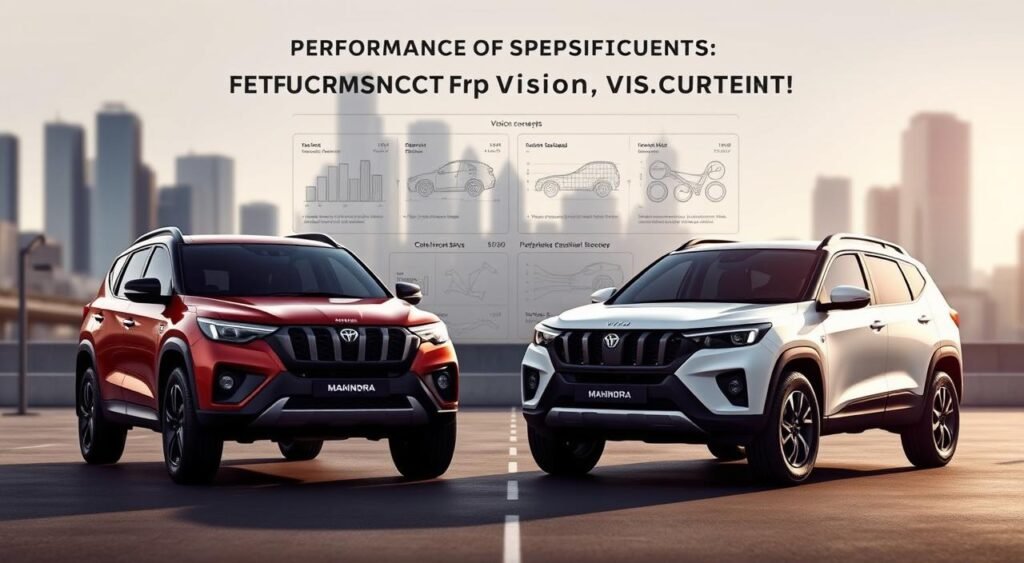
Handling and Driving Experience
The Mahindra SUV Comparison shows current models excel in different driving scenarios. The XUV700 has sporty handling with its suspension setup. The Scorpio-N is rugged.
Future Mahindra Concept Vehicles will have advanced chassis technologies for better ride quality. Electric variants will have instant torque, changing acceleration. The Nu IQ platform will improve weight distribution and lower center of gravity, better in electric models.
Consumer Preferences and Market Trends
The Indian car market is changing fast. Now, features found in luxury cars are expected in more affordable ones. Panoramic sunroofs are a big hit, showing how people want their cars to feel more luxurious.
Insights into Buyer Behavior
When looking for a new car, Indians focus on space, features, and value. Families want cars that are both practical and fancy. The desire for panoramic sunroofs shows they want to enjoy their drive without spending too much.

Car makers are now adding panoramic sunroofs to more cars. The Kia Carens, for example, offers this feature in its HTX+ variants. These cars are priced between Rs 11.50-21.50 lakh, showing how companies can offer luxury at a good price.
Demand for Electric and Hybrid Models
More and more Indians are interested in electric cars. Mahindra is leading the way with its Vision concepts. The data shows that many are now considering electric cars when they shop.
| Buyer Priority | Traditional SUVs | Electric/Hybrid Interest |
|---|---|---|
| Fuel Economy | 75% | 92% |
| Environmental Impact | 45% | 88% |
| Technology Features | 68% | 85% |
Pricing Strategies: Vision Concepts vs. Current Lineup
Mahindra carefully sets prices for its SUVs. They aim to be competitive and offer great value. The brand wants to match rivals’ prices but also add special features that make the cost worth it.
Cost Comparison with Existing Models
The Mahindra XUV700 is priced between Rs 14.50-25.14 lakh (ex-showroom). This makes it a strong contender in the premium SUV market. It goes head-to-head with other top players in India.
| SUV Model | Price Range (Rs Lakh) | Key Segment |
|---|---|---|
| Mahindra XUV700 | 14.50 – 25.14 | Premium SUV |
| Kia Carens | 11.50 – 21.50 | 3-Row MPV |
| Hyundai Alcazar | 15.00 – 21.74 | Premium SUV |
| Tata Safari | 15.50 – 27.44 | Premium SUV |
| MG Hector Plus | 17.50 – 23.94 | 3-Row SUV |
Premium features like panoramic sunroofs affect prices. For example, the Kia Carens HTX+ turbo-petrol variant costs Rs 21.50 lakh. This shows how advanced tech can raise prices.
Expected Pricing for Future Concepts
The Vision.T concept will likely enter the lifestyle SUV market. It will compete with the Mahindra Thar and others. Electric versions of future models will likely cost more due to battery tech and electric powertrains.
Future Outlook for Mahindra SUVs
Mahindra’s future in the SUV market is looking bright. The Vision.T concept is leading the way. It shows the company’s commitment to combining traditional toughness with modern technology.
The latest updates reveal plans to change how Indian consumers see electric vehicles. Mahindra aims to keep its reputation for building reliable, rugged vehicles.
Anticipated Features in Upcoming Models
The Nu IQ platform is at the core of Mahindra’s SUV development. It supports both electric and traditional powertrains. This makes the transition to electric vehicles smoother for buyers.
Future Mahindra models will have advanced connectivity features. These features will rival smartphones, allowing drivers to control various functions through mobile apps and voice commands.
Safety is a top priority with enhanced Advanced Driver Assistance Systems (ADAS). These include automatic emergency braking, lane-keeping assist, and adaptive cruise control. Mahindra will also use sustainable materials in vehicle interiors.
This includes recycled plastics and eco-friendly fabrics. These changes show Mahindra’s commitment to environmental responsibility. They do so without sacrificing comfort or style.
Potential Impact on the Indian Market
The Vision.T makes Mahindra a serious player in India’s electric SUV segment. This move could shake up the market, dominated by internal combustion engines. It offers practical alternatives to established models from Tata Motors and MG Motor India.
As charging infrastructure improves, these new Mahindra SUV updates could attract tech-savvy buyers. They are looking for greener transportation options. The competitive pricing strategy combined with advanced features might force other manufacturers to speed up their electric vehicle programs.
This would benefit Indian consumers with more choices and better technology.
FAQ
What is the Mahindra Vision.T concept and how does it compare to current Mahindra SUVs?
The Mahindra Vision.T is an updated version of the Mahindra Thar E concept. It’s built on the Nu IQ platform. It has a 5-door layout and a boxy SUV look.
Unlike current models like the XUV700, the Vision.T is an all-electric SUV. It offers both ICE and EV powertrains. This makes it a great alternative to the Mahindra Thar, Thar Roxx, and Force Gurkha.
What are the key features of Mahindra concept vehicles compared to existing models?
Mahindra concept vehicles like the Vision.T have advanced features. These include a large vertical touchscreen and a digital driver’s display. They also have a sports car-inspired starter button on the steering wheel.
Current models like the XUV700 have a 10.25-inch dual-screen setup. They also offer connected car technology and ADAS features. The Vision.T’s platform supports both ICE and EV powertrains, showing Mahindra’s move towards electric mobility.
How does Mahindra SUV technology in Vision concepts differ from current lineup?
The Vision.T concept has advanced connectivity and ADAS systems. While the XUV700 has ADAS technology and all-wheel-drive options, the Vision.T supports both ICE and EV versions.
This shows Mahindra’s commitment to electric mobility and sustainable materials. The Vision.T platform is designed for both ICE and EV powertrains.
What are the design differences between Mahindra future models and current SUVs?
The Vision.T has a traditional boxy SUV look but with modern touches. It has a six-slat split grille and squared headlights. The bumper is chunky and blacked out.
Current models have a more contemporary design. The XUV700, for example, has a panoramic sunroof from the AX5 trim. It follows modern SUV design trends.
What is the expected pricing for Mahindra SUV updates and future concepts?
The Vision.T’s pricing is yet to be announced. It’s expected to be competitive with the Mahindra Thar and Force Gurkha. The XUV700 is priced Rs 14.50-25.14 lakh ex-showroom.
In the competitive segment, rivals include the Hyundai Alcazar and Tata Safari. The MG Hector Plus is also a competitor. Electric versions of future concepts will likely have a premium price.
Which are the top Mahindra SUVs currently available and how do they compare?
The Mahindra XUV700 is the top model in the lineup. It has 200 PS turbo-petrol and 185 PS diesel engines. It also has ADAS technology and a panoramic sunroof from the AX5 trim.
It’s priced Rs 14.50-25.14 lakh. It competes directly with the Tata Safari and offers superior power output and advanced features.
What powertrain options will Mahindra SUV future models offer?
The Vision.T’s Nu IQ platform supports multiple powertrain options. This includes both ICE and EV versions, though specific details are unannounced. Current Mahindra models offer diverse engine choices.
The XUV700 has a 200 PS 2-litre turbo-petrol and a 185 PS 2.2-litre diesel. Both are available with manual and automatic transmissions. All-wheel-drive is available on select variants.
How is the Mahindra SUV review comparing Vision concepts to current models?
The Vision.T concept shows Mahindra’s evolution in SUV design. It combines traditional ruggedness with modern technology. It has an upright dashboard and a dual-tone interior theme.
Compared to current models like the XUV700, the Vision.T has a vertical touchscreen and a unique steering-mounted starter button. This makes Mahindra a leader in the electric SUV space.

Aug
Did you know Mahindra unveiled an electric SUV concept that could change India’s off-road market? The Mahindra Vision T Concept debuted on India’s 79th Independence Day. It brings excitement to electric vehicles with its rugged design and advanced tech.
The Vision T Concept is an electric version of Mahindra’s beloved Thar. It has unique design features that make it stand out. Built on the NU IQ platform, it has six exclamation mark-shaped grille slats and LED pixel DRLs. It also has strong bumpers with bright yellow tow hooks.
Many car fans saw this groundbreaking vehicle. But, there are key details about the Mahindra Vision T Concept that are not well-known. It has a flexible design that supports both front-wheel and all-wheel drive. It also has the chance to be sold in international markets with left and right-hand drive options.
Key Takeaways
- The Mahindra Vision T Concept debuts as an electric version of the popular Thar off-roader
- Features innovative design elements including six exclamation-shaped grille slats and LED pixel DRLs
- Built on the flexible NU IQ platform supporting multiple powertrain configurations
- Offers both FWD and AWD options with the chance for global market expansion
- Maintains the iconic boxy silhouette while incorporating modern electric vehicle technology
- Showcases Mahindra’s commitment to developing versatile platforms for future vehicles
A Brief Overview of the Mahindra Vision T Concept
The Mahindra Vision T Concept is a big step for the Indian car maker towards electric cars. It was shown at the Mahindra auto show with three other concepts. This tough SUV shows Mahindra’s big plans for the future of cars.
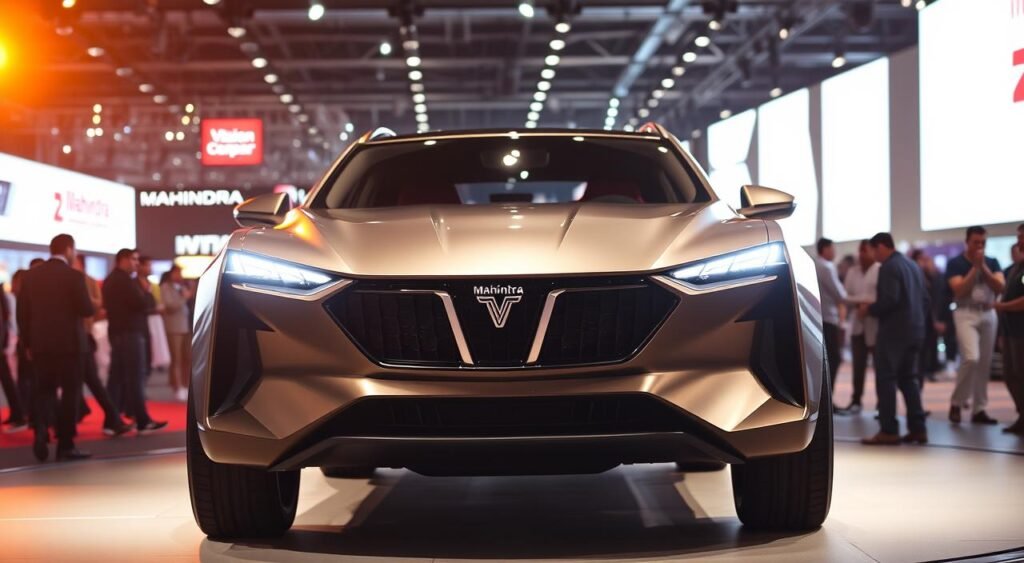
Introduction to the Mahindra Vision T
The Vision T Concept is based on the popular Thar lineup but is electric. It has cool design features that keep its off-road spirit alive. It has big wheel arches, exposed door hinges, and strong tires for off-road adventures.
Key design features include:
- Tailgate-mounted spare wheel with dual-tone alloy designs
- Chunky all-terrain tires for superior grip
- Rugged exterior styling with modern touches
- Evolution of the Thar E concept shown in South Africa in 2023
Significance in Mahindra’s EV Strategy
The Vision T is key in Mahindra’s plan for electric cars. It will be made between late 2027 and early 2028. This shows Mahindra’s goal to make all its cars electric, even the tough off-road ones.
By making an electric version of its famous off-road car, Mahindra shows that green cars can be adventurous too. The Vision T Concept connects eco-friendly driving with the thrill of off-road adventures.
Innovative Design Features of the Vision T
The Mahindra future car, the Vision T Concept, is a bold step forward. It combines rugged capability with modern styling. This design appeals to young buyers who want adventure and modern comforts.
The concept shows Mahindra’s commitment to evolving their design. They keep the essence that makes their vehicles stand out.
Exterior Aesthetics and Functionality
The Vision T Concept’s exterior is a perfect mix of looks and practicality. Its front has striking LED headlamps and integrated DRLs for a unique light. The chunky bumper has fog lamps and exposed bonnet latches for a rugged look.
The side profile keeps the classic boxy shape off-road fans love. It has:
- Squared-off wheel arches for better ground clearance
- Blacked-out ORVMs for a sporty look
- Dual-toned alloy wheels for style and durability
- Exposed door hinges for utility
- Jerry can behind the C-pillar for longer trips
The rear has vertical tail lamps that match the DRL pattern. A strong bumper with a silver skid plate shows its off-road strength.
Interior Layout and Technology Integration
Inside, technology is key without overwhelming the driver. The cabin has a large touchscreen display for controlling the car. A curved driver’s display shows important info, and the 3-spoke steering wheel is comfortable for any drive.
| Interior Feature | Description | Benefit |
|---|---|---|
| Portrait Touchscreen | Large vertical display | Enhanced visibility and control |
| Curved Driver Display | Floating digital cluster | Improved ergonomics |
| Physical Controls | Tactile buttons return | Easier operation off-road |
| Dark Theme Interior | Premium materials | Sophisticated ambiance |
The Vision T Concept shows a return to physical button controls. This is because tactile feedback is key for driver confidence. The dark theme interior adds sophistication and is practical for those who value durability and easy maintenance.
Advanced Technology: What to Expect
The Mahindra electric vehicle is packed with the latest tech. It uses the NU IQ platform, which is super flexible. This platform supports electric, hybrid, and traditional powertrains.
It can fit different body styles and drivetrain layouts. This makes it great for both front-wheel and all-wheel drive setups.
AI and Connectivity Innovations
The Vision T Concept has a big portrait display system. It’s the heart of connectivity, showing navigation, entertainment, and vehicle controls. Mahindra balances digital innovation with practical physical buttons.
This ensures drivers can access important functions easily. It keeps them focused on the road.
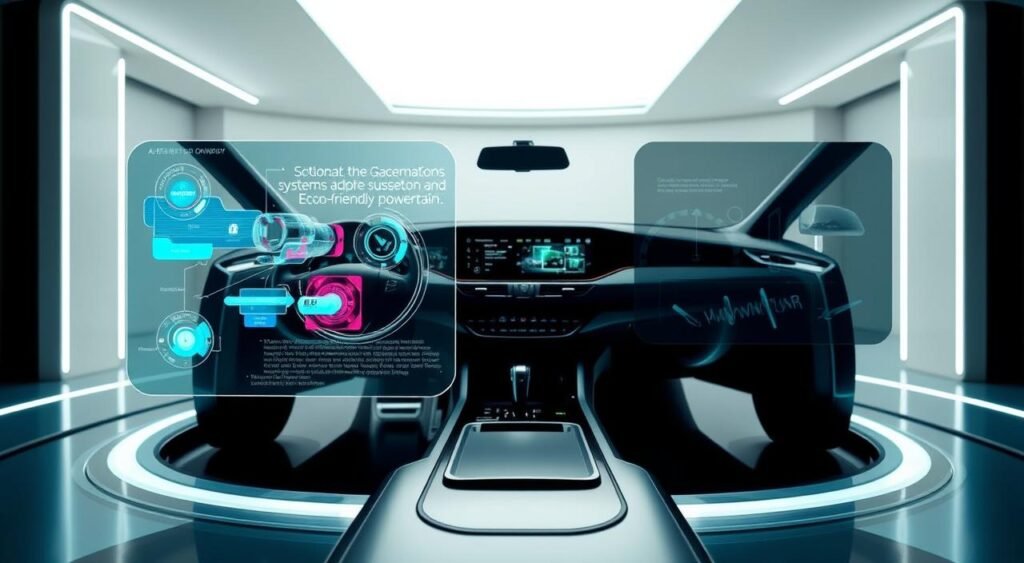
- Smartphone integration for seamless device pairing
- Real-time traffic updates and route optimization
- Over-the-air software updates for continuous improvement
- Voice command systems for hands-free operation
Safety Features and Enhancements
The NU IQ platform brings advanced driver assistance systems to the Vision T Concept. These safety technologies protect occupants in city driving and off-road adventures. The platform’s design supports enhanced visibility and collision prevention.
The Mahindra electric vehicle has sensors all over to watch the surroundings. These systems alert drivers to hazards and can act to prevent accidents. The platform works well for both left-hand and right-hand drive without losing safety.
Sustainable Practices Behind the Mahindra Vision T
The Mahindra Vision T shows the company’s dedication to the environment. It combines new sustainable tech with the brand’s rugged look. Built on the IQ platform, it proves electric cars can be tough and green.

Eco-Friendly Materials Used
The Vision T uses recycled plastics and bio-based materials inside. Its seats are made from ocean waste, and the trim is bamboo. These choices cut down on carbon emissions without losing comfort or strength.
The battery casing is made from 95% recyclable aluminum. Even the floor mats are from recycled rubber. This shows Mahindra’s focus on green details in every part.
Energy Efficiency and Performance Goals
The IQ platform helps the Vision T meet high efficiency goals. It supports different powertrain options:
- Pure electric setup with over 400 kilometer range
- Hybrid for longer trips
- Regenerative braking to save up to 30% energy
Plans to start production in late 2027 match India’s EV goals. The Vision T’s creation shows Mahindra’s plan to make electric cars for all, keeping performance high.
Market Positioning of the Mahindra Vision T
The Mahindra Vision T Concept is a game-changer in India’s electric vehicle scene. It’s an off-road electric SUV that stands out from the usual city-focused EVs. At the Mahindra auto show, it showed how it can handle both rough outdoor adventures and city driving.
Target Demographics in India
The Vision T is designed for India’s young people, with a bold, Gen-Z-inspired look. It targets young professionals aged 25-35 who love adventure and city life. It keeps the legendary Thar brand’s tough vibe but adds modern electric tech.
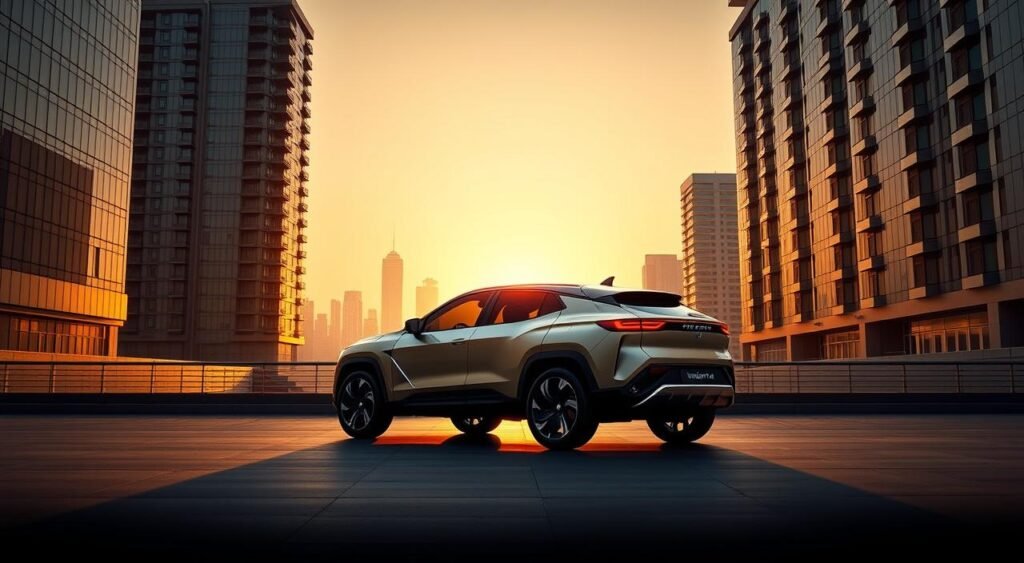
Urban millennials who care about the planet and performance are also key buyers. They want an EV that shows they’re eco-friendly and love adventure. The Vision T’s tech features, like advanced connectivity and AI, are perfect for India’s tech-loving youth.
Competitive Analysis with Other EVs
The Vision T is a pioneer in the electric off-roader market in India. Unlike others, it’s made for both city and off-road use. Its NU IQ platform allows it to be driven on either side, setting it up for global markets.
Future Vision: Mahindra’s Longer-Term Goals
Mahindra has big plans for electric vehicles in India. They aim to change the car market with a clear plan. They will launch many models in the next five years, each for a different market segment.
Expansion Plans in the EV Market
The first step is the Vision S in early 2027. It will enter the premium Mahindra electric vehicle market. Later in 2027, the Vision T and Vision SXT will join the lineup, adding more variety.
The Vision SXT is a pickup truck with a unique design. It has twin spare wheels and a bold black-and-orange interior.
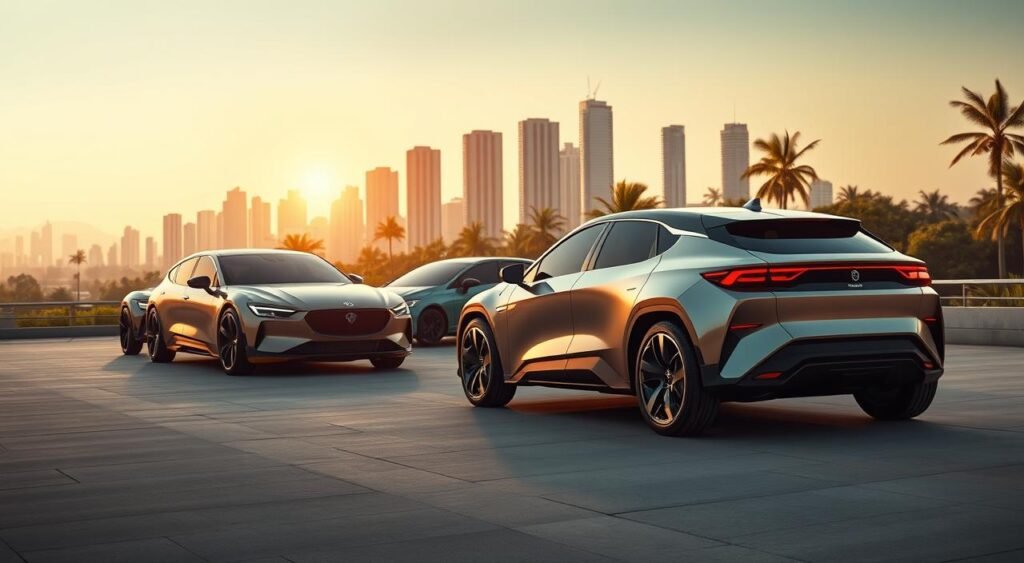
By mid-2028 to early 2029, the Vision X will arrive. It’s aimed at the compact SUV market. This shows Mahindra’s dedication to electric options at various price points.
Upcoming Models and Concepts in Development
Each Mahindra Concept car brings new features to different markets. The Vision X concept has LED headlights and a closed-off grille. It also has 19-inch alloy wheels and NFC door access for easy entry.
All new models will use the NU IQ platform. This platform supports different powertrains. It helps Mahindra develop cars faster and more affordably, without sacrificing quality.
Customer Reactions and Industry Buzz
The Vision T Concept was the star at the Mahindra auto show. It caught the eye of fans and experts. This electric off-roader talked about the future of India’s Thar lineup, mixing tradition with new tech.
Initial Impressions from the Auto Expo
People at the Independence Day showcase were really excited. They loved the Vision T Concept’s look. It took the classic Thar design and made it modern but kept it familiar.
What really drew people in was:
- Rugged exterior styling with modern electric vehicle touches
- A tech-savvy interior with a big portrait display
- A design that’s young and adventurous
- It kept the off-road skills but went green
Media Coverage and Expert Opinions
Car journalists loved how Mahindra showed off electric vehicles. The Vision T Concept was a hit for making the Thar name bigger. It could win over young people who want green adventure cars.
Experts said it’s part of Mahindra’s big EV plan. They talked about the feature-rich interior and bold exterior design. They think it could do well in India’s changing car market.
Conclusion: The Future of Mahindra in the EV Space
The Vision T concept is a big step for Mahindra’s electric car plans. It shows the company’s commitment to making electric cars for all. They aim to start making these cars by late 2027 or early 2028.
Implications for Electric Vehicle Adoption in India
The Vision T could change how people in India see electric off-road cars. It’s built on a flexible platform that can meet various needs. This comes at a time when more Indians care about the environment.
Electric versions of popular SUVs might make people choose cleaner cars over gas ones.
Final Thoughts on the Vision T Concept
After launching the BE 6 and XEV 9e, the Vision T shows Mahindra’s full electric plan. It’s a car that combines old-school ruggedness with new tech. This electric off-roader is ready for city driving and tough trails.
The Vision T shows electric cars can do it all, from city streets to rough terrains.
FAQ
When will the Mahindra Vision T Concept enter production?
The Mahindra Vision T is set to hit the market between late 2027 and early 2028. This follows the Vision S, which is expected in early 2027. It’s a key part of Mahindra’s electric vehicle plans.
What platform is the Vision T built on?
The Vision T uses Mahindra’s new NU IQ platform. This platform is very flexible. It supports different powertrains like ICE, EV, and hybrid. It also works for FWD and AWD, and can be made for left-hand and right-hand drive for global markets.
Is the Vision T related to the Mahindra Thar?
Yes, the Vision T is an electric version of the Thar. It keeps the Thar’s boxy look but adds modern touches. It’s an updated version of the Thar E concept from 2023.
What are the key design features of the Mahindra electric vehicle?
The Vision T has a cool front with six rectangular slats and LED DRLs. It also has chunky bumpers and yellow tow hooks. The design includes squared-off wheel arches and all-terrain tires. It even has a tailgate-mounted spare wheel.
How does the Vision T fit into Mahindra’s broader EV strategy?
The Vision T is part of Mahindra’s four-concept showcase. It joins the Vision S, Vision X, and Vision SXT. It’s a key part of Mahindra’s electric vehicle strategy, aiming for a unique spot in the market.
What technology features can we expect in the Vision T’s interior?
The Vision T’s interior is packed with tech. It has a large touchscreen display and a 3-spoke steering wheel. The cabin will have a dark theme, blending tech with practicality.
Will the Vision T be available only as an electric vehicle?
The Vision T is shown as an electric concept. But its NU IQ platform can handle different powertrains. This means Mahindra might offer various options to meet market needs.
What was the public reaction to the Vision T at the Mahindra auto show?
The Vision T got a lot of buzz at the Independence Day showcase. People loved how it updated the Thar’s design. It was seen as a hit with Gen-Z, blending ruggedness with modern style.

Aug
When Mahindra unveiled four Vision concepts on Independence Day, the car world buzzed. The Vision SXT is a standout, reimagining the SUV pickup. It has more to offer than you might think.
The Mahindra Vision SXT Concept breaks the mold of traditional pickup designs. It’s based on the 2023 Thar.e concept, combining passenger comfort with cargo space. It’s set for production in late 2027 or early 2028, allowing for fine-tuning.
So, what’s so special about the Mahindra Vision SXT Concept? Its architecture is key. It merges passenger and cargo areas into a single design. It has an exposed deck, roll bars, and a unique rectangular tailgate panel.
Two vertically mounted spare tires in rally-style yellow add both style and practicality. This design is a bold move.
Underneath, the Vision SXT has Mahindra’s new NU_IQ modular monocoque platform. It’s made for SUVs between 3990-4320mm long. This platform offers great versatility.
The Vision SXT has a 2665mm wheelbase, beating the Hyundai Creta’s 2610mm. It offers more cabin space while keeping a tight 10.3-meter turning radius.
Key Takeaways
- Production of the Mahindra Vision SXT Concept confirmed for late 2027 or early 2028
- Built on the innovative NU_IQ modular monocoque platform for enhanced versatility
- Features a merged passenger and cargo area design with exposed deck and roll bars
- Offers a 2665mm wheelbase providing superior cabin space compared to competitors
- Incorporates rally-inspired design elements including vertically mounted spare tires
- Achieves an impressive 10.3-meter turning radius despite its larger dimensions
Overview of the Mahindra Vision SXT Concept
The Mahindra Vision SXT is a bold move in the world of concept cars. It’s a pickup-style vehicle that shows Mahindra’s big plans for the lifestyle pickup market. It combines ruggedness with modern design, aiming to meet the needs of today’s drivers.
The Vision Behind the Concept
Mahindra’s Vision SXT is designed to fill a gap in the Indian market. It’s a pickup that’s made for India’s roads but also looks good globally. It was created by teams in Mumbai and the UK, showing how international collaboration can lead to something new.
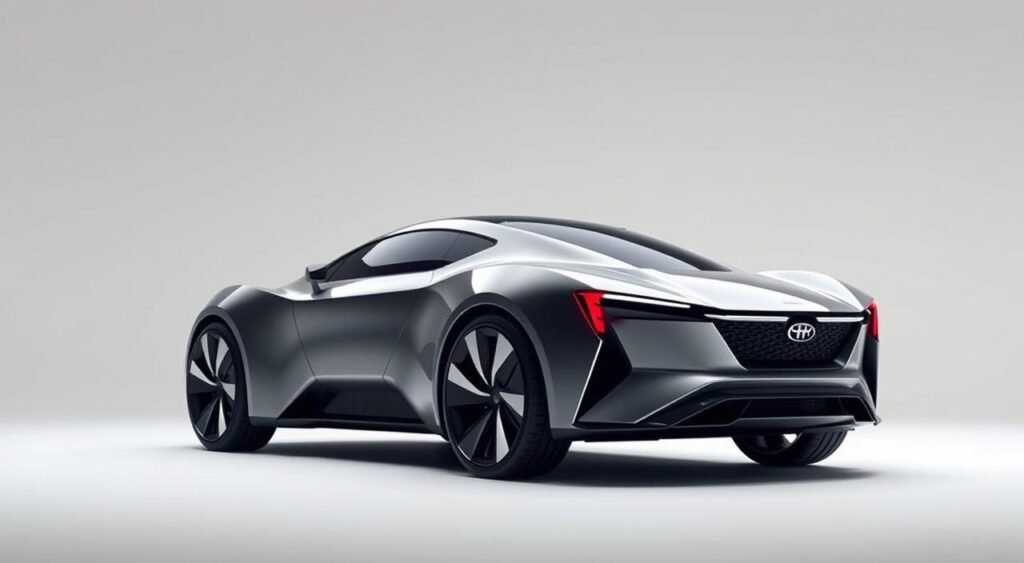
Design Philosophy and Aesthetics
The Vision SXT takes cues from the Thar.e, with its unique headlights and long grille. It has:
- Upright bonnet with exposed latches
- Bulked-up bumper for enhanced road presence
- Prominent wheel arches accommodating chunky off-road wheels
- Glass-encased lower grille section
- C-pillar-mounted rear door handles
- Practical roof carrier hooks
These features give it a wide stance that grabs attention and is also very functional.
Performance Features Highlighted
The Vision SXT is all about performance, with its all-terrain tires and strong build. It has exposed door hinges and a tough body, ready for tough conditions. It’s designed for both city driving and off-road adventures, fitting India’s varied landscapes well.
Innovative Technology in the Vision SXT
The Mahindra Vision SXT is a technological leap forward in the Future of Mobility. It combines practicality with the latest innovations. The interior is both modern and easy to use.
Cutting-Edge Infotainment System
The Vision SXT’s tech is powered by Mahindra’s NU_UX software. It has a large screen and a digital instrument cluster. This setup offers top-notch connectivity for Indian users.
It also has physical buttons for important functions. This makes it safe to use without getting lost in menus.
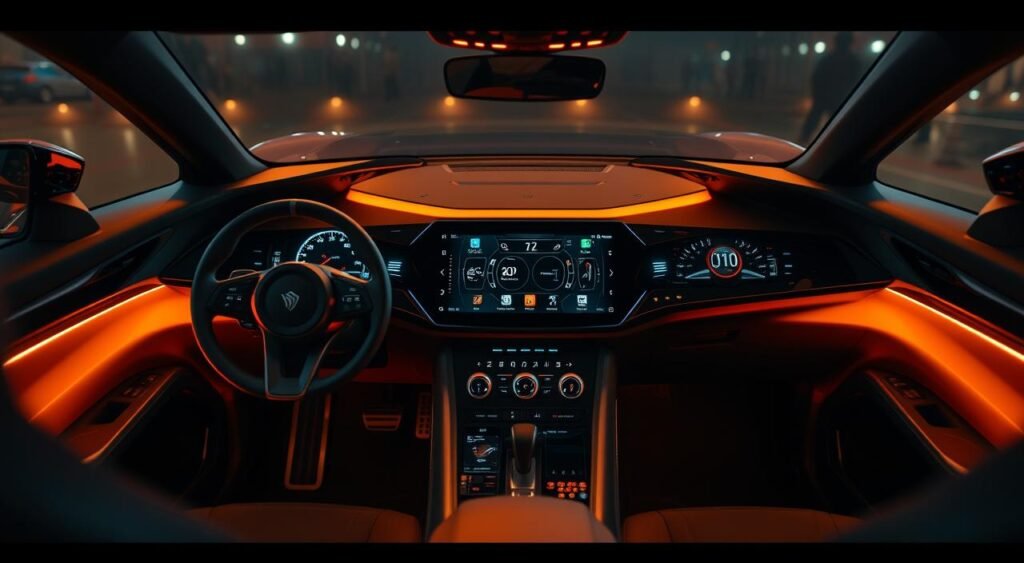
Advanced Safety Features
Safety is a top priority in the Vision SXT. It aims for 5-star ratings from GNCAP and Euro NCAP. The NU_IQ architecture supports many safety systems.
This includes smart sensors and protective tech. It’s all about keeping you safe.
Autonomous Driving Capabilities
The Vision SXT offers semi-autonomous driving. It uses the NU_IQ platform for different drive types. This lets the NU_UX software adjust to various conditions.
This ensures safety and performance in all types of vehicles. It’s a big step towards the Future of Mobility.
Sustainability in the Mahindra Vision SXT
The Mahindra Vision SXT is a big step towards green cars. It’s built on the NU_IQ platform, showing Mahindra’s dedication to eco-friendly cars. This platform is smart, allowing for different powertrains and saving resources during making.

Eco-friendly Material Choices
Mahindra chose sustainable materials for the Vision SXT. It has recycled plastics and bio-based composites for a smaller environmental footprint. It also uses lightweight aluminum and carbon fiber for better efficiency and strength.
Energy Efficiency and Electric Powertrain
The Vision SXT’s electric powertrain is both powerful and green. It can run on electric or traditional engines, giving buyers choices. Its design helps it go further on less energy, making it a top choice for eco-conscious drivers.
| Feature | Sustainability Benefit |
|---|---|
| Modular Platform | Reduces manufacturing waste by 30% |
| Lightweight Construction | Improves energy efficiency by 15% |
| Recycled Materials | Decreases carbon footprint by 25% |
| Aerodynamic Design | Extends driving range by 10% |
Target Market and Future Prospects
The Mahindra Vision SXT Concept is aimed at a specific group in the fast-growing lifestyle pickup segment. It shows Mahindra’s grasp of changing tastes and market shifts in India.
Intended Audience for the Vision SXT
The Vision SXT is for those who love adventure and city life, looking for a versatile vehicle. It’s perfect for families who need practicality but also style. Young professionals in cities are increasingly looking for such vehicles in India.
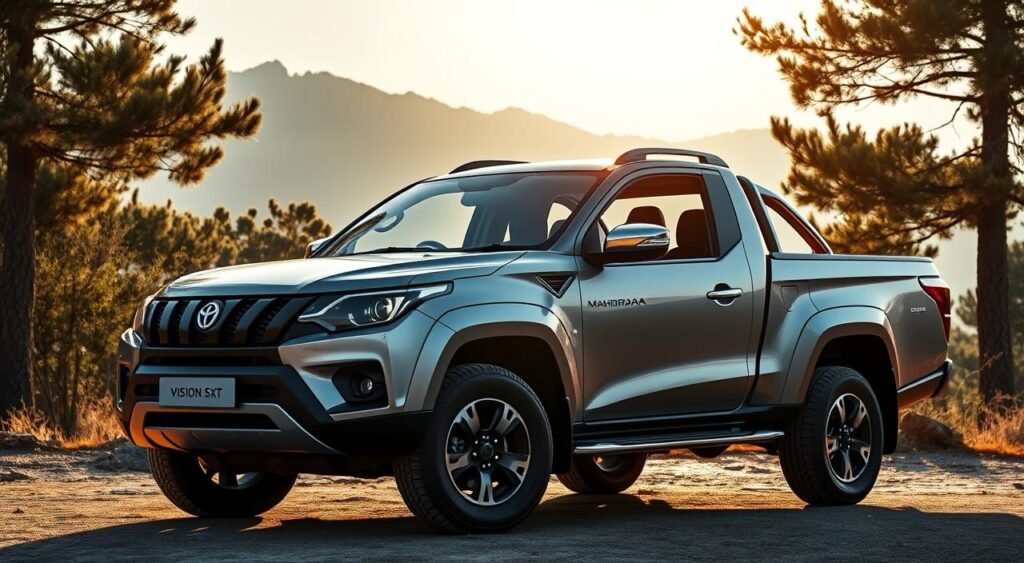
It’s for people aged 25-45 who enjoy outdoor activities and weekend trips. They need a car that’s good for city driving and fun adventures. The Vision SXT meets these needs with its design.
Market Positioning Strategy
Mahindra uses its Thar heritage to offer modern features and tech. The Vision SXT will be launched between late 2027 and early 2028. This follows the Vision S’s introduction in early 2027.
| Vehicle Model | Launch Timeline | Target Segment |
|---|---|---|
| Vision S | Early 2027 | Premium Electric SUV |
| Vision SXT | Late 2027 – Early 2028 | Lifestyle Pickup |
| Vision T | 2028 | Electric Truck |
The Indian market faces challenges like varied roads. The Vision SXT is built to handle these with strong engineering. Mahindra’s history of turning Independence Day concepts into real cars makes the Vision SXT a strong contender.
Comparative Analysis with Competitors
The Mahindra Vision SXT enters a crowded electric vehicle market. It stands out with bold design choices. These choices challenge the usual pickup truck formulas.
Its competitive analysis shows it has advantages in space, maneuverability, and versatility. These features set it apart from established players.
Rivals in the Electric Vehicle Segment
The Vision SXT competes with various electric crossovers and pickups in India. Key rivals include the Hyundai Creta EV, Tata Nexon EV, and upcoming electric pickups from major manufacturers. Each competitor has its own strengths.
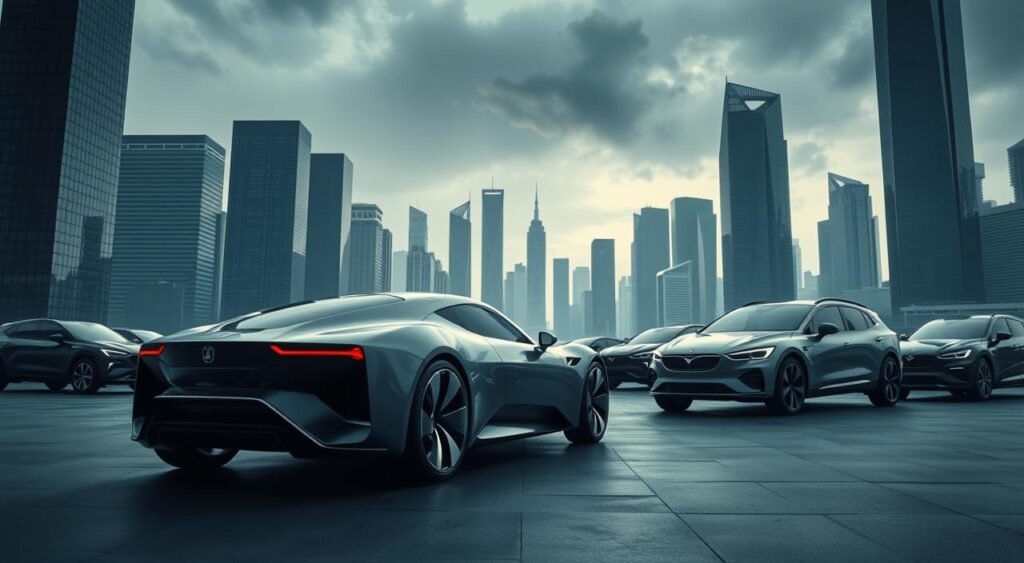
| Vehicle Model | Wheelbase | Turning Radius | Powertrain Options |
|---|---|---|---|
| Mahindra Vision SXT | 2665mm | 10.3m | Multiple (EV/Hybrid) |
| Hyundai Creta | 2610mm | 10.6m | Single (Petrol/Diesel) |
| Tata Nexon EV | 2498mm | 10.5m | Electric Only |
Unique Selling Propositions
The Vision SXT’s market differentiation comes from its innovative design. Twin spare wheels and vertical tail lamps make it stand out. Its platform supports multiple powertrains, giving Mahindra an edge.
It aims for 5-star safety ratings, setting it above many competitors. Despite a compact turning radius, it offers great cabin space. This makes it easy to navigate cities.
Its rugged capability and premium technology make it appealing. It attracts both commercial and personal users.
Conclusion: The Future of Mobility with Mahindra
The Vision SXT is a bold step into the future of mobility by Mahindra. It joins the Vision S, Vision T, and Vision X in showing Mahindra’s new approach to car design. The NU_IQ platform supports all four, showing Mahindra’s commitment to modular and green car innovation.
Anticipated Impact on the Automotive Industry
The Vision SXT could change India’s utility vehicle market by 2028. Its unique design challenges traditional pickup truck ideas. The NU_IQ platform allows for both electric and gas engines, meeting different customer needs.
Final Thoughts on the Vision SXT Concept
Mahindra has a history of turning concepts into real cars, making the Vision SXT’s future look bright. The Vision series is set for production from 2027 to 2029. The Vision SXT is more than a pickup truck; it’s Mahindra’s vision for the future of mobility.
FAQ
When will the Mahindra Vision SXT Concept enter production?
The Mahindra Vision SXT Concept will hit the market in late 2027 or early 2028. This follows Mahindra’s plan for their Vision series. The Vision S is set to launch in early 2027.
What platform will the Vision SXT be built on?
The Vision SXT will be built on Mahindra’s NU_IQ modular monocoque platform. This platform is made for SUVs between 3990-4320mm in length. It supports various powertrains like petrol, diesel, hybrid, and electric, in both FWD and AWD.
How does the Vision SXT differ from traditional pickup trucks?
The Vision SXT has a unique design that combines the passenger area and cargo space into one. It has a distinctive look with rally-style yellow spare tyres and seats five people. This makes it versatile for different needs.
What are the key dimensions of the Vision SXT?
The Vision SXT has a 2665mm wheelbase, longer than some rivals like the Hyundai Creta. It also has a 10.3m turning radius for easy city driving. It promises to have the most cabin space in its class.
Will the Vision SXT be available as an electric vehicle?
The production powertrain for the Vision SXT is not yet confirmed. But, the NU_IQ platform is ready for full electrification. This means it could have both ICE and EV options for eco-friendly driving.
What safety standards will the Vision SXT meet?
The Vision SXT aims for 5-star safety ratings with GNCAP and Euro NCAP standards. This puts it ahead of many current cars, showing Mahindra’s focus on safety.
Who is the target audience for the Vision SXT?
The Vision SXT is for those who love adventure and need a practical vehicle. It’s perfect for families who want a car that’s good for both daily use and weekend trips.
What technology features will the Vision SXT include?
Inside, you’ll find a simple dashboard with physical buttons and a digital cluster. There’s also a large infotainment screen. It runs Mahindra’s NU_UX software for top-notch connectivity. Plus, it has a panoramic sunroof for camping.
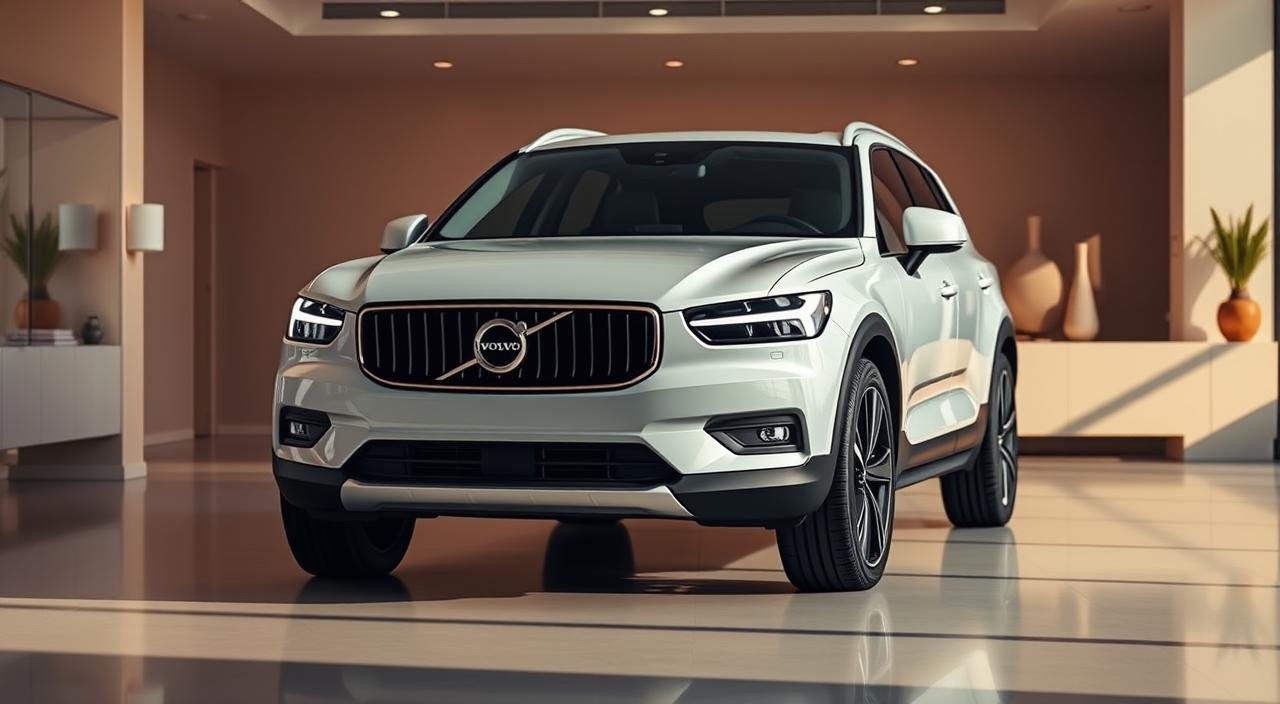
Aug
Can a compact electric SUV from Volvo really deliver the same premium experience as its larger siblings while being wallet-friendly? The answer might surprise you when it comes to the Volvo EX30 Electric SUV review.
The Volvo EX30 marks a bold new chapter for the Swedish automaker in India. It’s not another massive luxury cruiser like the XC90 or the refined XC60. Instead, Volvo has created a compact electric SUV that fits perfectly into urban environments.
At just 4.2 meters long, the EX30 packs surprising capability into a footprint similar to a large hatchback. The car carries all the familiar Volvo DNA while adding fresh, youthful character. This sets it apart from its siblings. Despite being called Volvo’s “baby,” this electric SUV proves that good things come in small packages.
The EX30’s journey to India tells an interesting story. Designed in Sweden and developed in China – the world’s largest electric vehicle producer – it will be assembled in Bangalore. This global collaboration has already earned recognition, with the EX30 winning the 2023 BBC Top Gear Eco Warrior of the Year award in the UK.
Set to launch in September, the EX30 will compete directly with the Mini Cooper SE in the premium compact electric segment. With expected pricing between Rs 35-40 lakh thanks to local CKD assembly, it promises to make Volvo’s electric technology more accessible. Built on a dedicated electric platform shared with the Smart #1 and Zeekr X, the EX30 represents the future of urban mobility.
Key Takeaways
- The Volvo EX30 is the brand’s smallest and most affordable electric SUV in India
- Compact 4.2-meter length makes it perfect for city driving
- Won the 2023 BBC Top Gear Eco Warrior of the Year award
- Expected pricing between Rs 35-40 lakh with local assembly in Bangalore
- Built on dedicated electric platform shared with Smart and Zeekr
- Launching in September to compete with Mini Cooper SE
Impressive Design That Turns Heads
The Volvo EX30 stands out on Indian roads with its unique style. It combines boxy and curved shapes, unlike most cars. The Thor’s Hammer daytime running lights have a cool grid pattern.
The rear lamps stretch almost the whole back, grabbing everyone’s attention. These features make the EX30 a head-turner.
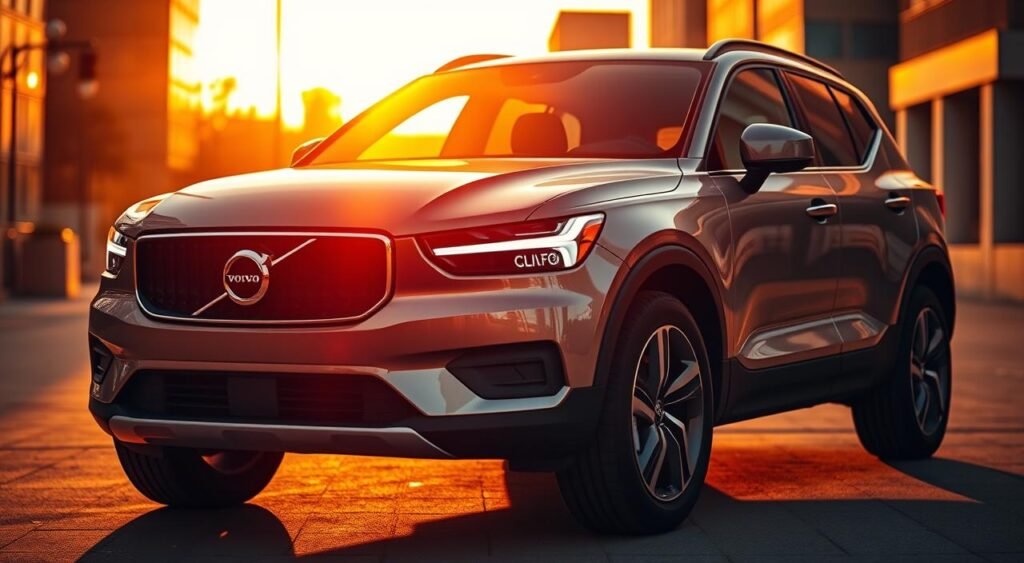
Sleek and Modern Aesthetic
The front of the EX30 is clean, without a traditional grille. A big Volvo badge and a diagonal stripe make it stand out. Chunky door handles add a personal touch.
The 19-inch wheels add drama. Every side of the EX30 shows off its modern design and Volvo’s heritage.
Eco-Friendly Materials Used
Inside, the EX30 focuses on being green. The Indian model uses recycled plastic, while other versions have recycled denim. No leather is used in the interior.
The dashboard and door panels have a premium feel. They’re made from recycled materials with a stone-like texture.
Customization Options Available
There are many colors to choose from, like Cloud Blue and Sand Dune. Most trims have two-tone paint, highlighting the EX30’s design. India doesn’t get the bright yellow option, but there’s plenty of choice for those who want to stand out.
Performance That Excites
The Volvo EX30 is a compact electric vehicle that rivals sports cars. It has a rear motor that produces 268 horsepower and 343 Nm of torque. This means it goes from 0-100 kmph in just 5.3 seconds.
The twin-motor version is even more powerful. It has 422 horsepower and can reach 62 mph in 3.6 seconds.
Instant Torque and Acceleration
Electric motors work differently than traditional engines. The EX30’s instant torque gives smooth, linear acceleration. This feels controlled, not chaotic.
The single-motor version is also impressive. It goes from 0-62 mph in 5.7 seconds. This makes it one of the best electric SUVs of 2021.
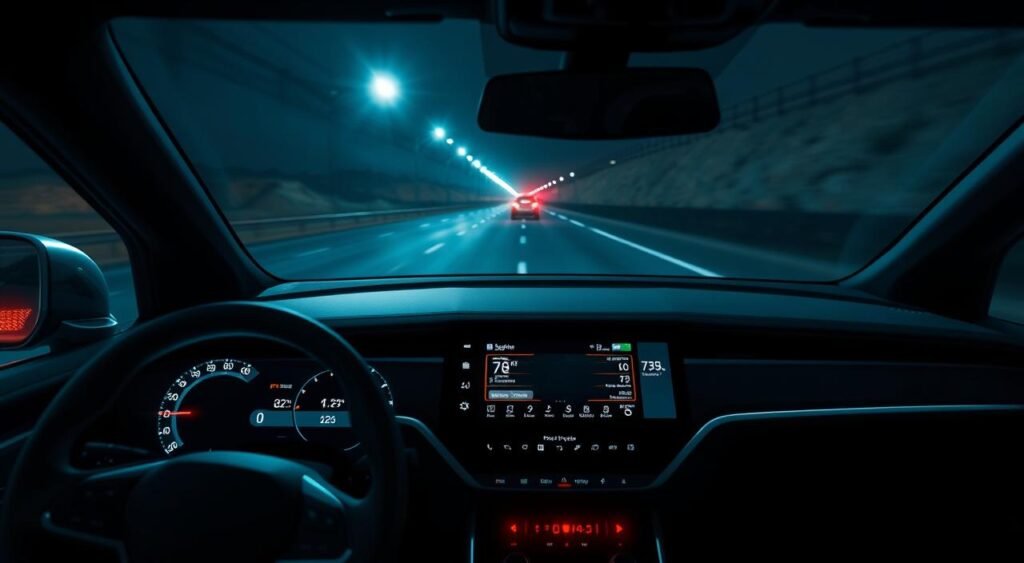
Efficient Battery Technology
Volvo offers two battery options for different needs. The 49 kWh LFP battery is sustainable. The larger 64-69 kWh NMC battery extends range even more.
Real-world tests show drivers can get 350-400 kilometers per charge. This makes long trips practical and stress-free.
All-Wheel Drive Capabilities
The EX30 has a low center of gravity for great balance and handling. Its chassis performs well on different roads. The suspension is well-damped, staying composed over rough surfaces.
The steering is quick and the stability is genuine. This makes the electric SUV performance stand out. Whether you choose rear-wheel or all-wheel drive, it’s impressive.
Advanced Safety Features
The Volvo EX30 Electric SUV review shows Volvo’s strong focus on safety. It has top-notch safety tech, just like bigger luxury cars. It even got a 5-star Euro NCAP crash test rating. This proves that even the smallest Volvo is safe.

Innovative Driver Assistance Systems
The Volvo EX30 has advanced Pilot Assist and adaptive cruise control. These keep the car safe and steady. The 360-degree camera system helps with parking, and blind-spot monitoring warns of dangers.
Rigorous Safety Ratings
The EX30 also has Volvo’s unique airbag system. It includes airbags in the front seats and between them. This comprehensive airbag system is designed to protect in all kinds of crashes.
Emergency Braking and Collision Avoidance
The EX30 has automatic emergency braking. It stops the car fast if needed. The collision avoidance system also steers away from obstacles.
But, some Indian drivers might find the lane-keep assist and speed warnings too much. Volvo made it easier to adjust these settings with updates. But, the menu is a bit hard to use.
Cutting-Edge Technology Integration
The Volvo EX30 is packed with advanced tech. It has a digital cockpit that changes how you drive. The car has a 12.3-inch vertical touchscreen in the middle. It runs on Qualcomm Snapdragon with Android OS.
This system replaces old gauges and controls with a simple digital interface. It makes driving more intuitive.
Intuitive Infotainment System
The EX30’s tech center is its infotainment system. It’s based on Android and lets you download apps from the Google Play Store. This makes driving better with real-time navigation and music.
Seamless Smartphone Connectivity
iPhone users can connect wirelessly with Apple CarPlay. Android users can use wired Android Auto. The EX30 also has a top-notch Harman Kardon sound system.
It has nine speakers and pumps out 1,040 watts of sound. The soundbar design fills the car with sound.
Over-the-Air Software Updates
The EX30 gets software updates without a trip to the dealer. These updates make the car better and add new features. The system downloads and installs them automatically when it’s connected to Wi-Fi.
Comfort and Space for Every Journey
The Volvo EX30 Electric SUV review shows a well-thought-out interior. It mixes Scandinavian minimalism with useful features. This small electric car uses every bit of space, making it feel bigger than it is.
Spacious Interior Layout
The interior takes a minimalist approach, like Tesla, but keeps Volvo’s Scandinavian look. The front seats are comfy for both short and long drives. The center console and window switches show smart use of space.
Among the best electric SUVs of 2021, the EX30 shines with its smart design.
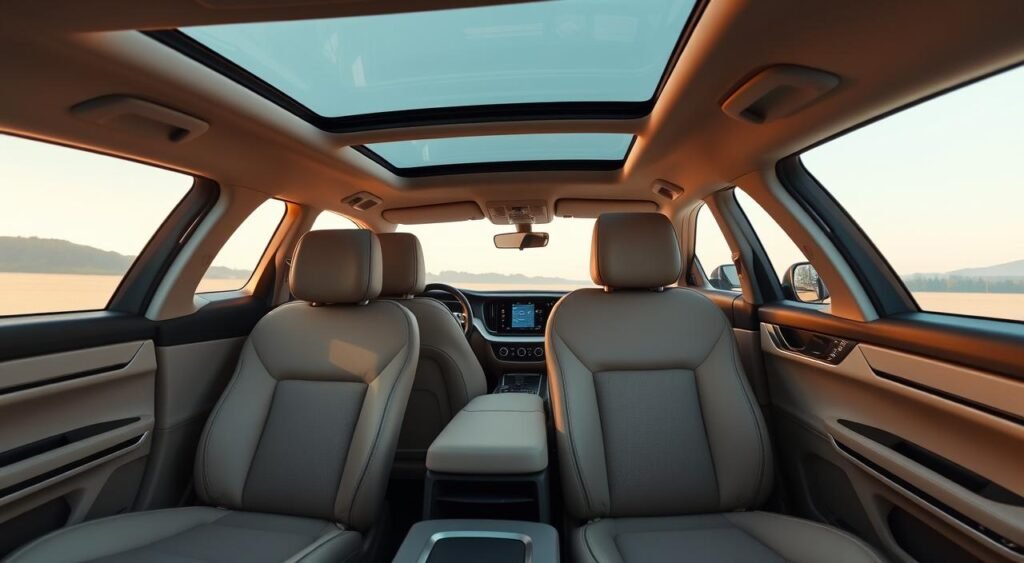
Premium Seating Options
The front seats are comfy, with soft fabrics and high-quality finishes. But, the rear seats are a bit tight, with cramped knees. There are no rear AC vents, which is a big issue in India’s hot climate.
Even with recycled materials, the interior feels luxurious, matching top brands.
Versatile Cargo Solutions
The EX30 is all about practical storage:
- 318-liter boot capacity with electric tailgate access
- 7-liter front trunk perfect for charging cable storage
- Removable tray system for rear passenger convenience
- Adjustable central storage compartments with retractable cupholders
- Enlarged door bins thanks to innovative soundbar placement
The Volvo EX30 Electric SUV review highlights its smart design. It offers surprising versatility in a small package. Each storage solution is designed with daily use in mind.
Sustainability Commitment of Volvo
Volvo leads in environmental efforts with the EX30. It sets high standards for electric SUVs. The company aims for clear goals and measurable results.
Carbon Neutral Manufacturing
Volvo’s factories in Belgium and China run on green energy. Most suppliers follow this green path. The EX30 has a low CO2 footprint of 18 tonnes when it leaves the factory.
For those driving 8,000 miles a year in India, the EX30’s CO2 output is just 0.4 tonnes. This is much less than the 1.8 tonnes from petrol cars.

Recyclable and Sustainable Materials
The EX30’s interior uses eco-friendly materials. It includes recycled denim, fishing nets, and plastic bottles. The base model uses LFP batteries, which need less mining than traditional batteries.
| Material Type | Recycled Content Percentage | Source Materials |
|---|---|---|
| Plastic Components | 16.7% | Disposable bottles, fishing nets |
| Steel Elements | 16.7% | Industrial recycled steel |
| Aluminum Parts | 25% | Post-consumer aluminum |
| Interior Fabrics | 100% | Recycled denim, uPVC frames |
Ethical Sourcing Practices
Volvo avoids leather in all trim levels. This shows its dedication to ethical choices. The EX30’s CO2 emissions are about half of what traditional cars produce.
These features show that being green and luxurious can go hand in hand. It cuts costs and environmental harm while keeping Volvo’s high standards.
Exceptional Driving Range and Efficiency
The Volvo EX30 is a top electric SUV with impressive range. It comes in different battery sizes to fit various needs. You can pick from three options, each designed for Indian roads.
Competitive Mileage on a Single Charge
The EX30’s range varies by model. The base model goes 209 miles on a single charge. The Single Motor Extended Range goes up to 295 miles. The Twin Motor Performance edition offers 280 miles, balancing power and efficiency.
For Indian roads, it’s estimated to go about 350 kilometers. This makes it great for daily drives and weekend trips.
Fast Charging Capabilities
Charging the EX30 is easy with several options. It supports 11 kW AC charging at home and up to 153 kW DC fast charging at public stations. This fast charging means you can quickly top up your battery on long trips.
Eco-Driving Features
The EX30 has features to boost efficiency and performance. One-pedal driving mode is great for city driving, letting you control speed with just the accelerator. The energy recuperation system captures power when you slow down, saving range.
The car is very quiet, with little wind noise and silent motor operation. Adaptive cruise control on highways helps save battery, making the single-motor version with a bigger battery the most efficient.
Overall Value and Affordability
The Volvo EX30 Electric SUV offers great value in the compact luxury electric vehicle market. In India, it’s priced between Rs 35-40 lakh for locally made models. This makes it a strong competitor to the Mini Cooper SE.
In the UK, prices start at £31,560 for the Core trim with rear-wheel drive. The Plus trim costs between £33,660 and £44,360, depending on features. The Ultra trim tops out at £41,860 to £44,360.
Cost-Effective Ownership
The EX30 faces competition from the BMW iX1 and Hyundai Ioniq 5 at Rs 45-50 lakh. Other rivals include the VW ID.3, Cupra Born, Renault Megane E-Tech Electric, Kia EV3, and Hyundai Kona Electric. Despite its high price, the Volvo brand adds a lot of value.
The car comes with unique features like NFC keys and advanced safety systems. These justify its luxury segment position.
Available Incentives for Electric Vehicles
Buying an electric vehicle comes with government incentives and tax breaks. The Volvo EX30 Electric SUV review highlights its lower CO2 emissions. This leads to lower registration fees and tax benefits in many areas.
The combination of incentives and Volvo’s prestige makes the EX30 appealing to eco-conscious luxury buyers.
Long-Term Savings on Fuel and Maintenance
Electric cars save on fuel costs, as owners only pay for electricity. This is much cheaper than petrol or diesel. The EX30 also needs less maintenance than traditional cars.
There are no oil changes, fewer parts, and regenerative braking helps brake pads last longer. These factors lead to big savings over time. The Volvo EX30 is known for its long-term value.
FAQ
What are the Volvo EX30 specifications for the Indian market?
The Volvo EX30 has a rear motor that makes 272 PS (268 bhp) and 343 Nm torque. It goes from 0-100 kmph in 5.3 seconds. It’s 4.2 meters long and has a 318-liter boot.
It comes with 49 kWh and 64 kWh/69 kWh battery options for longer range.
How does the Volvo EX30 compare to other best electric SUVs 2021?
The EX30 faces off against the Mini Cooper SE, BMW iX1, and Hyundai Ioniq 5. It’s priced at Rs 35-40 lakh for CKD assembly in India. This makes it Volvo’s most affordable electric car.
It won the 2023 BBC Top Gear Eco Warrior of the Year award in the UK. This shows it’s a strong competitor.
What electric SUV features make the EX30 stand out?
The EX30 has a 12.3-inch vertical touchscreen with Android OS and native Google apps. It also has wireless Apple CarPlay. It has a 5-star Euro NCAP rating and many safety features.
It also has a Harman Kardon soundbar with nine speakers and 1,040 watts output for premium sound.
How is the electric SUV performance in real-world conditions?
In real-world driving, the EX30 gets 350-400 km range in India. WLTP ratings range from 209 miles to 295 miles. It charges at 11 kW AC and up to 153 kW DC fast.
Its performance is smooth and the ride quality is excellent, even on rough roads.
What sustainability features does the Volvo EX30 Electric SUV review highlight?
The EX30 uses recycled materials like plastic, steel, and aluminum. It also uses recycled denim, fishing nets, and plastic bottles. The CO2 footprint is low, with only 18 tonnes from the factory.
It’s about half the CO2 of petrol cars. No leather is used in any trim.
